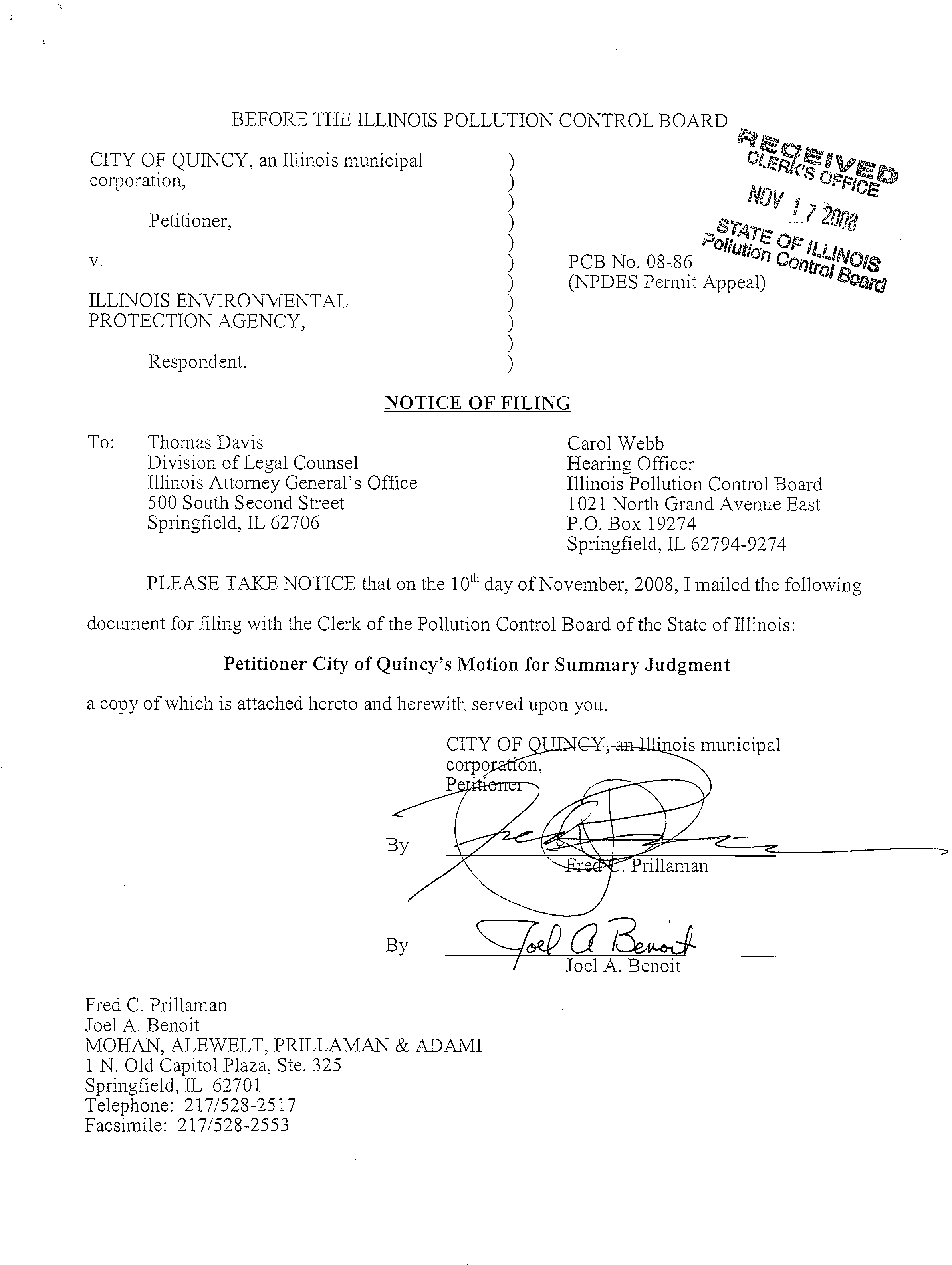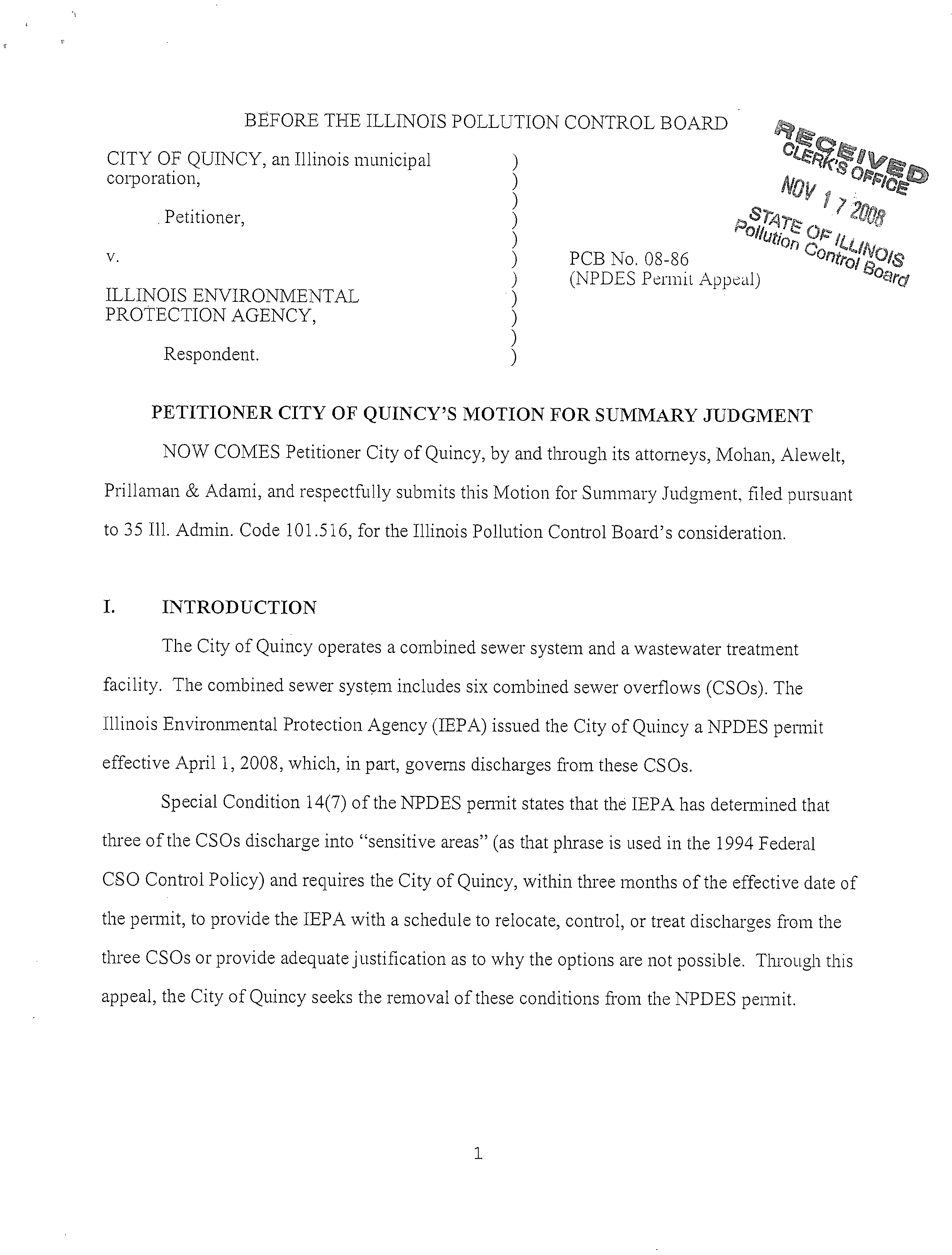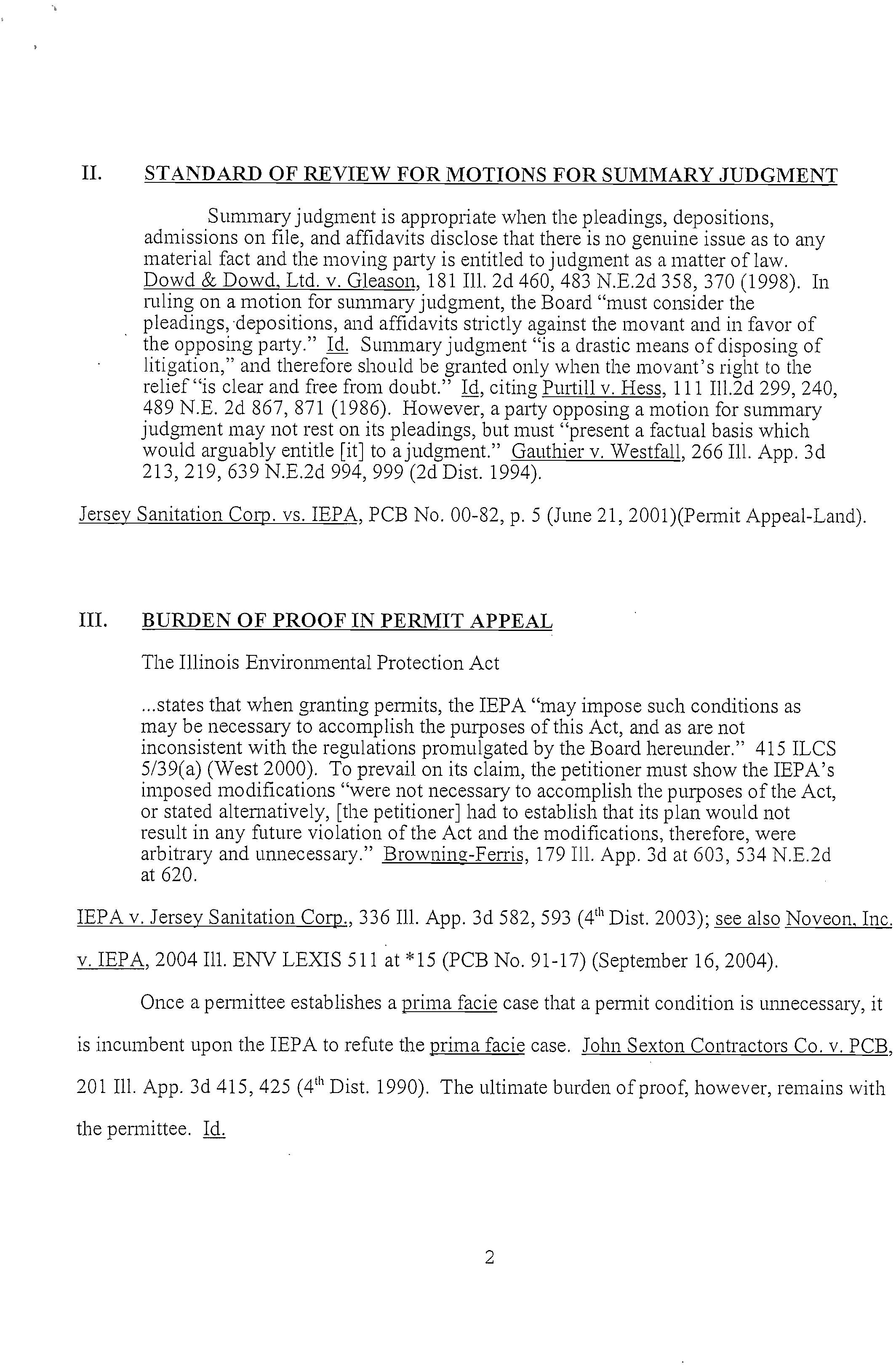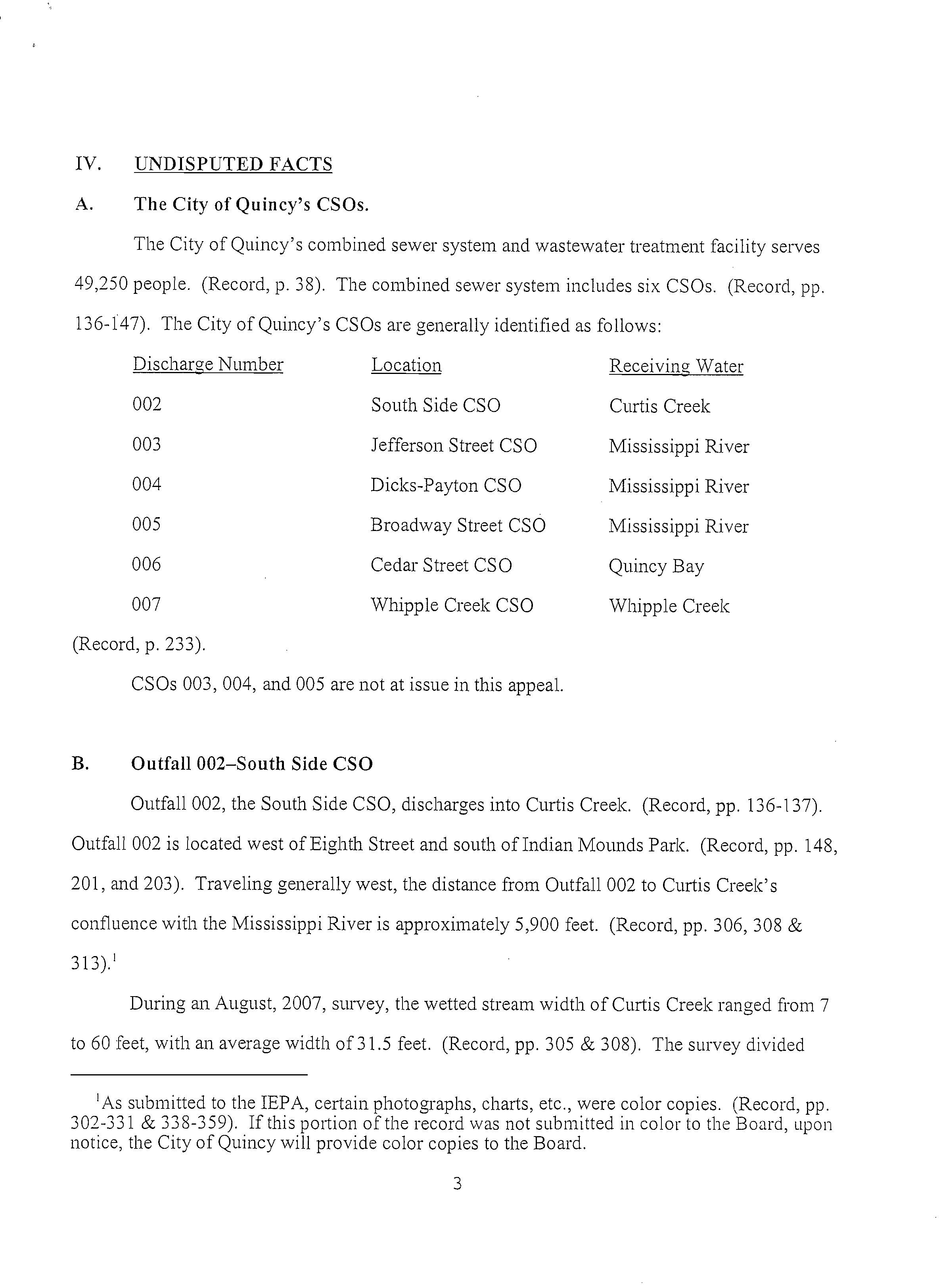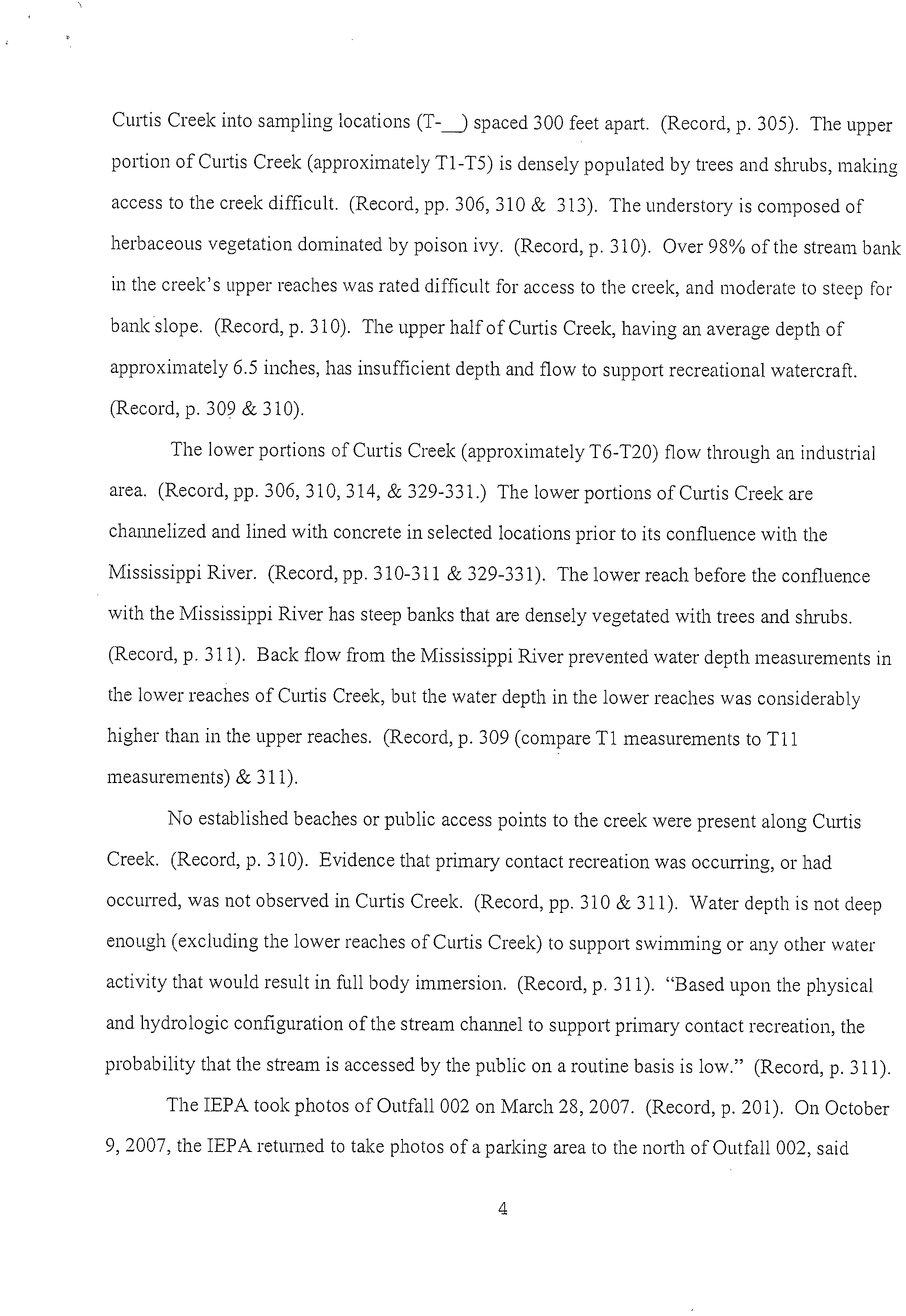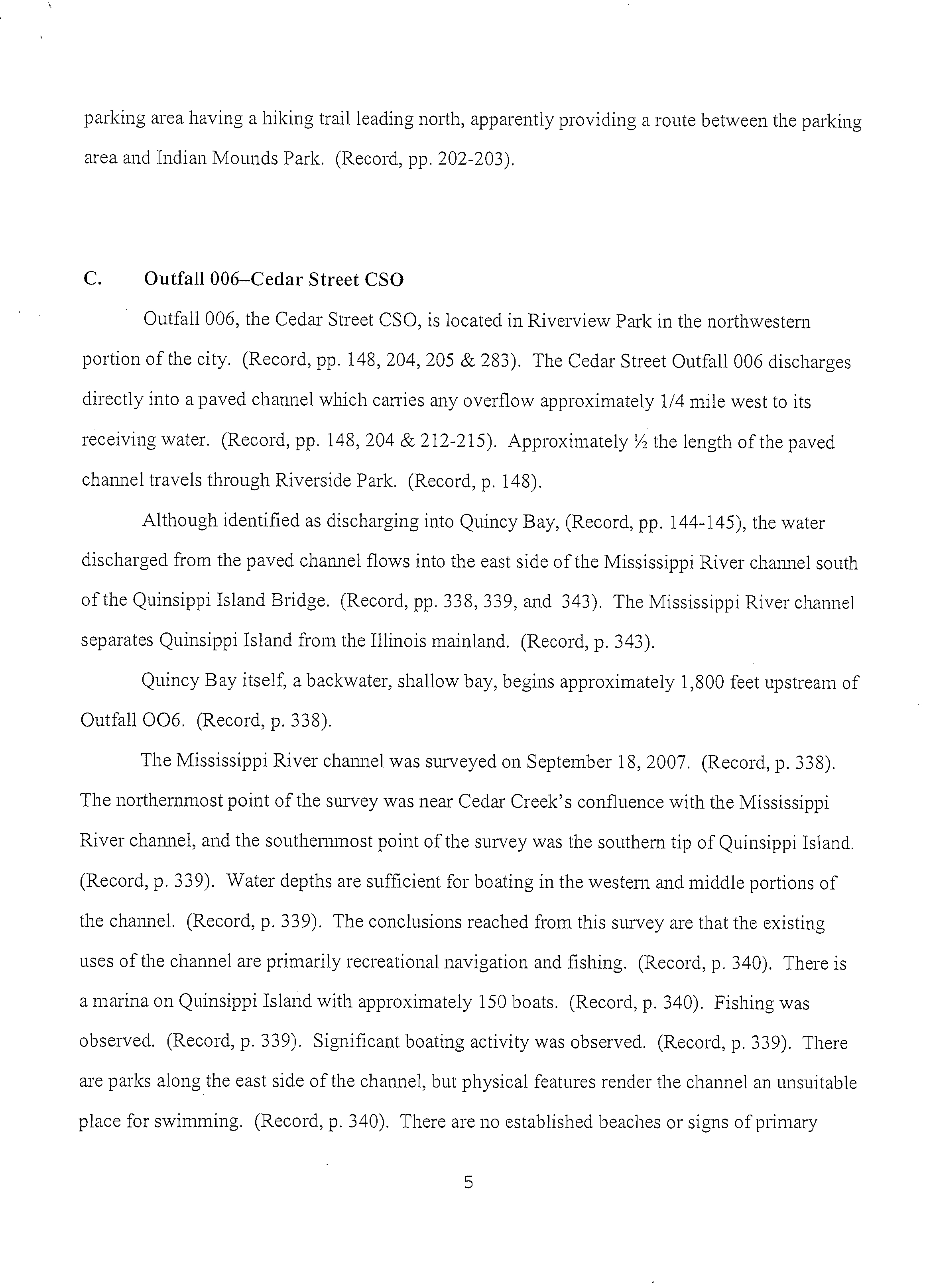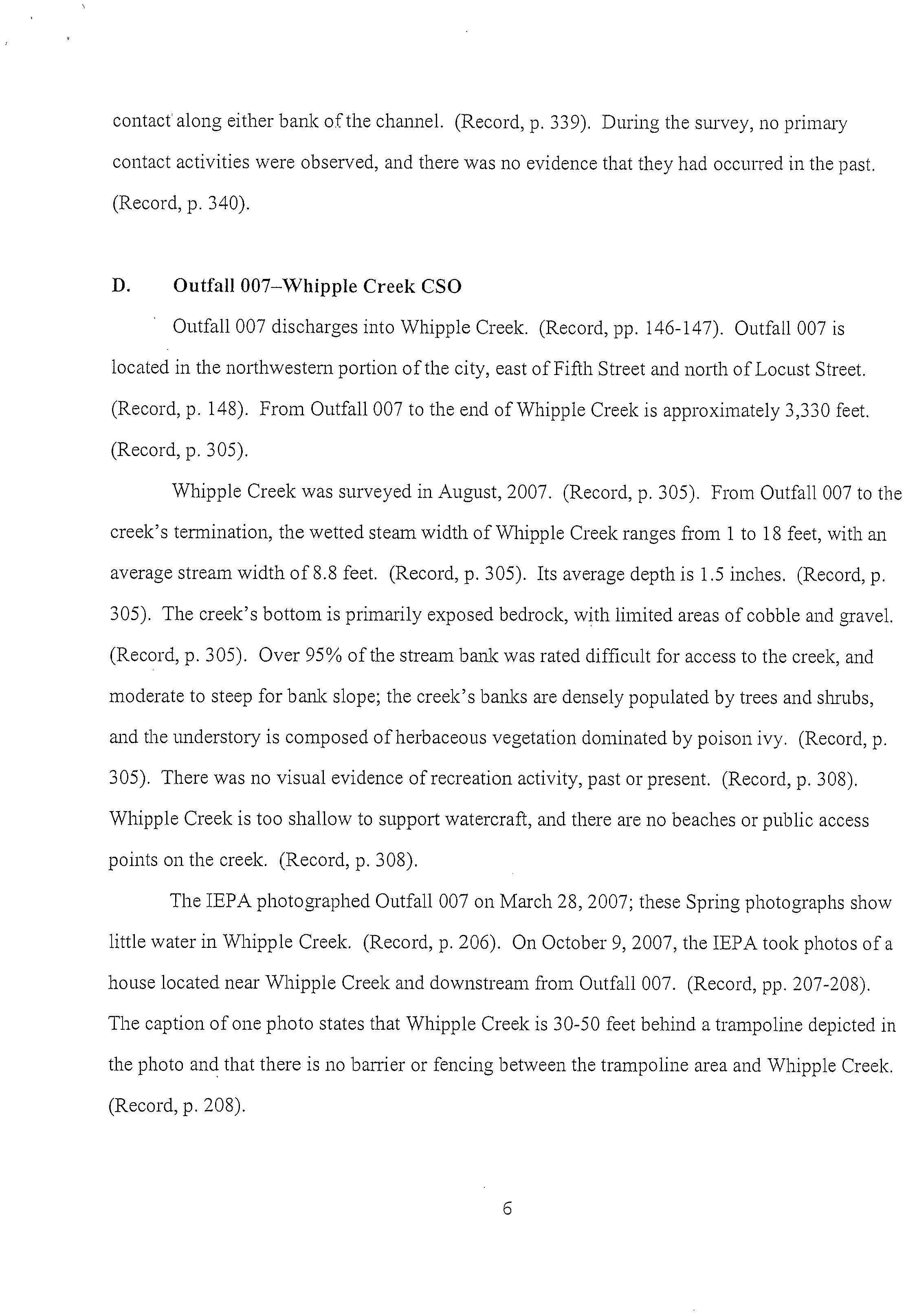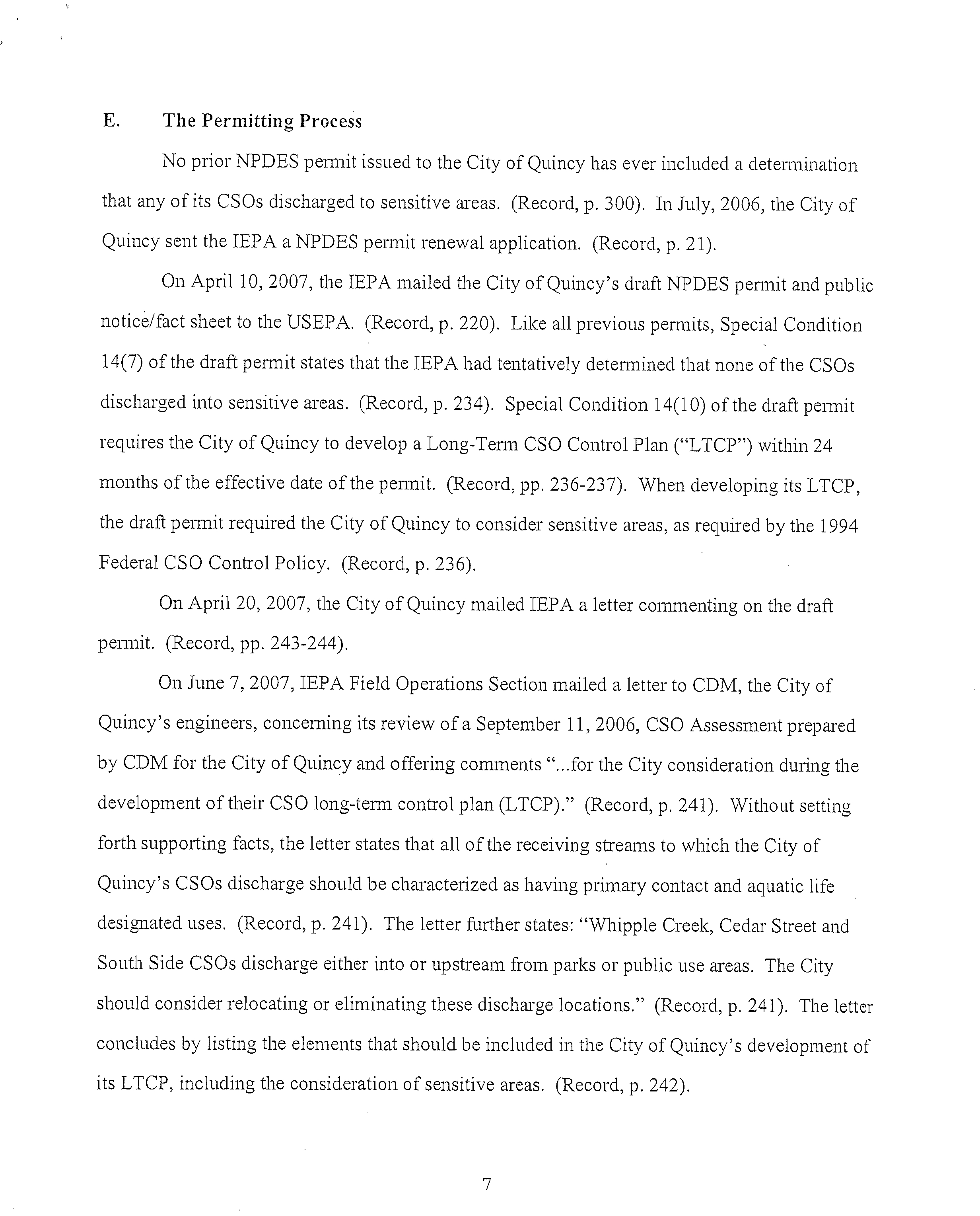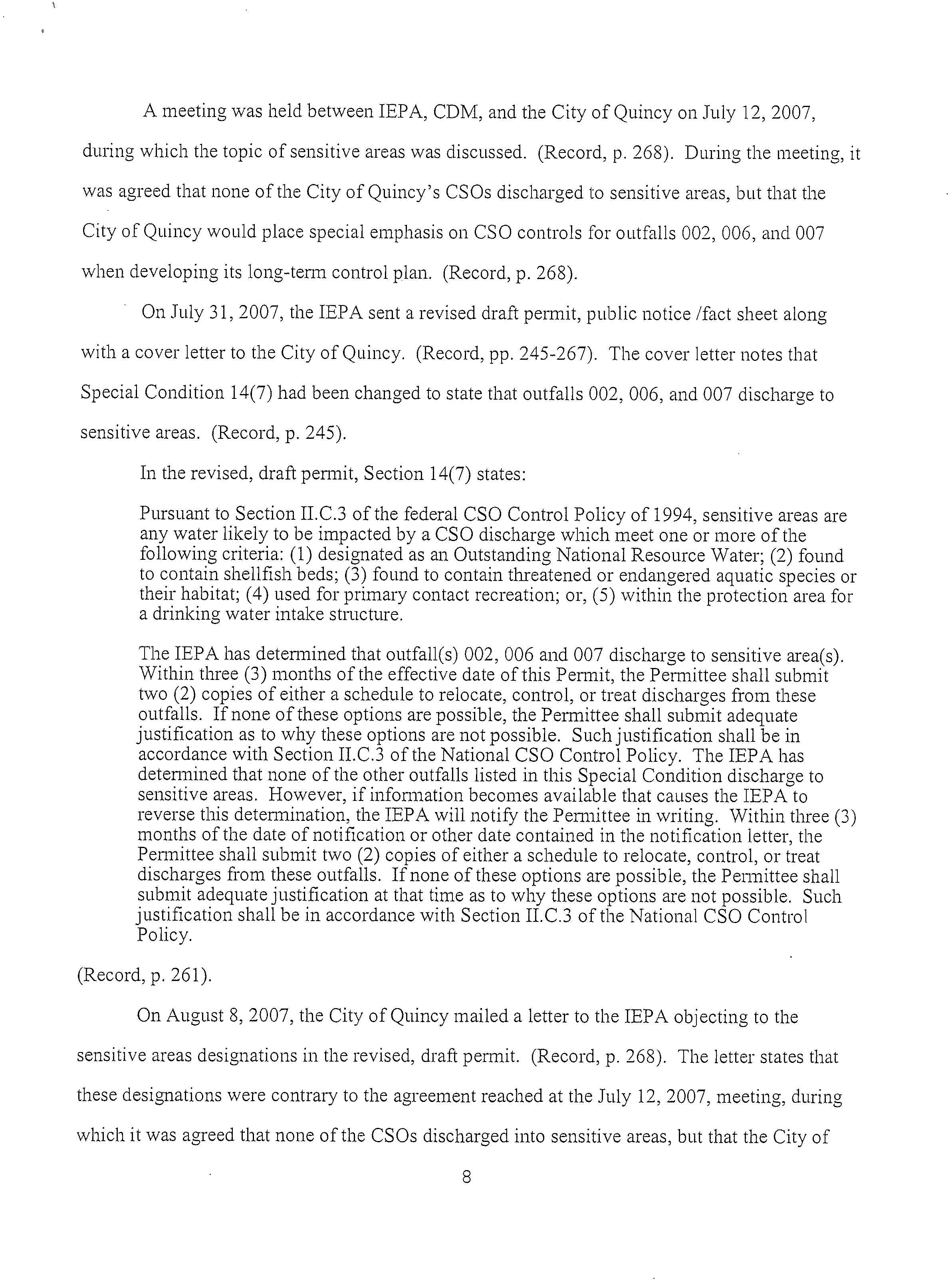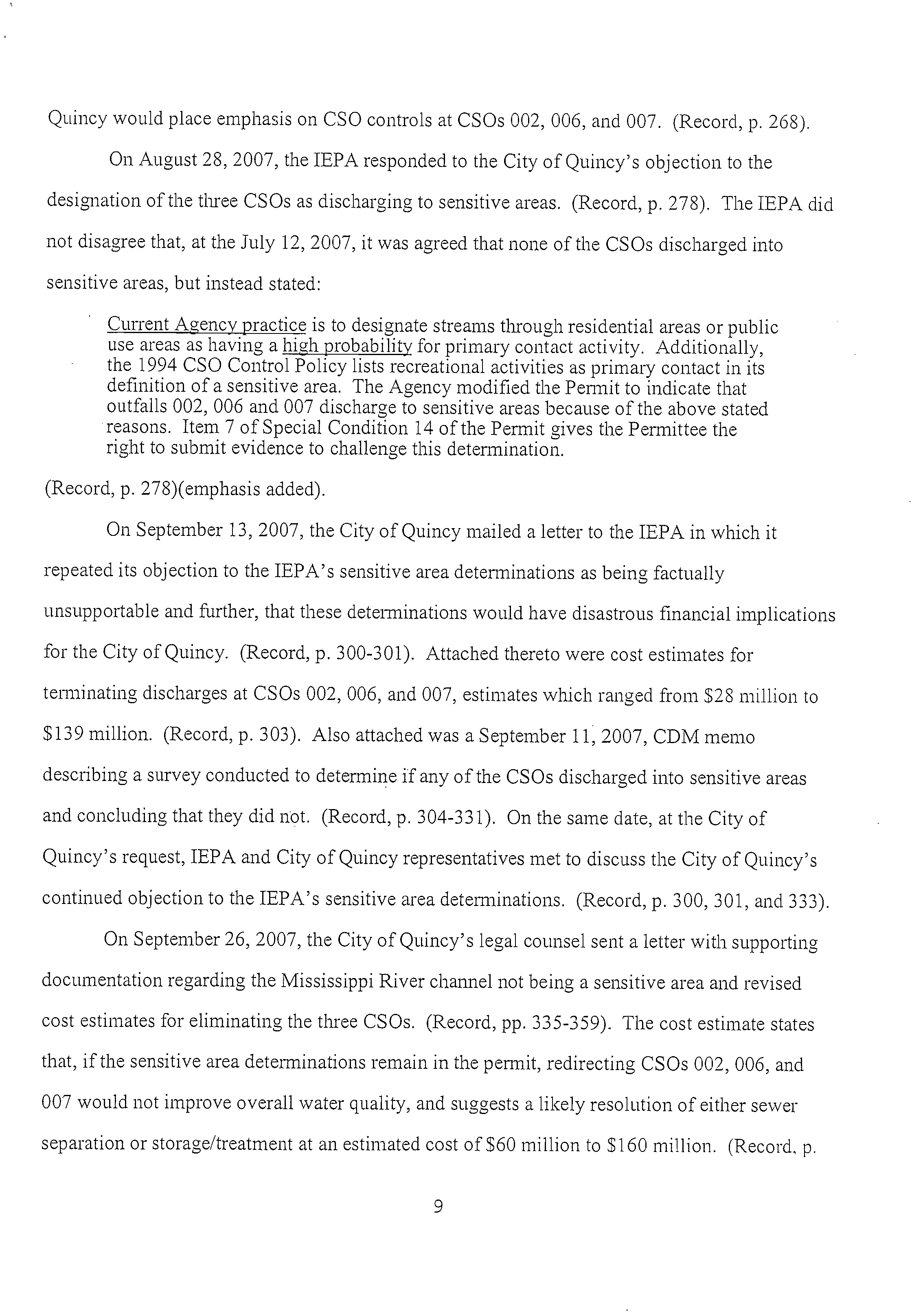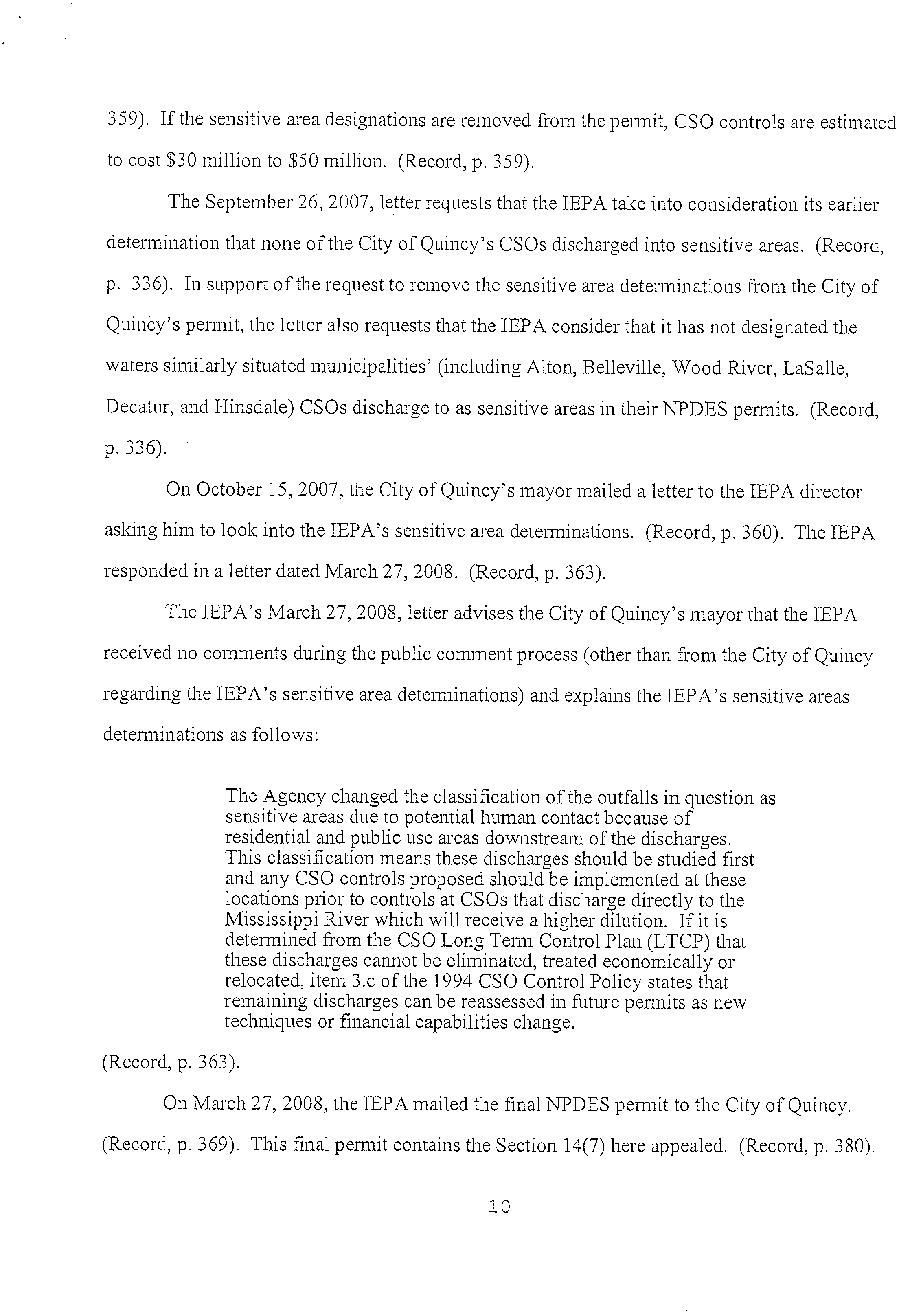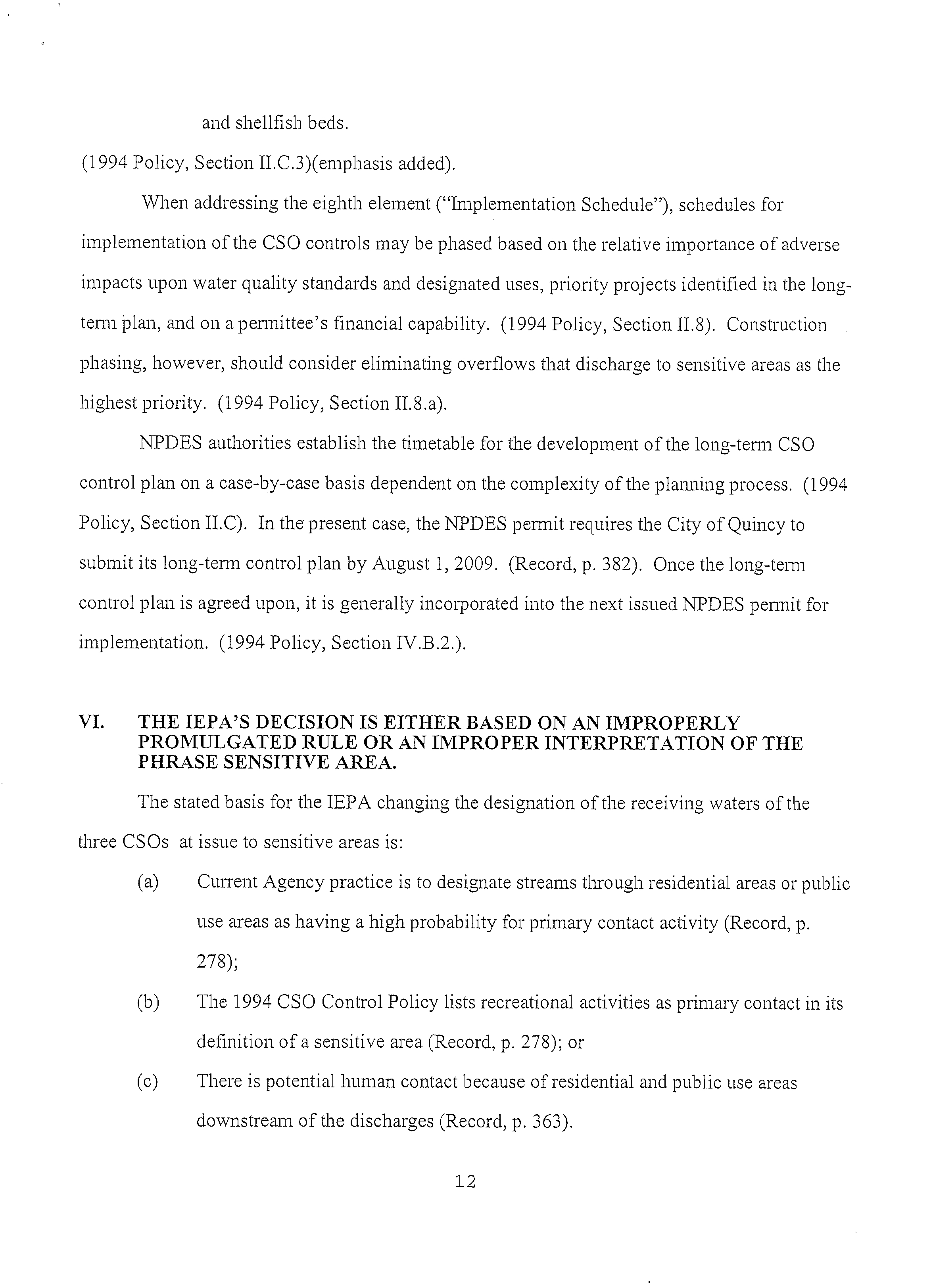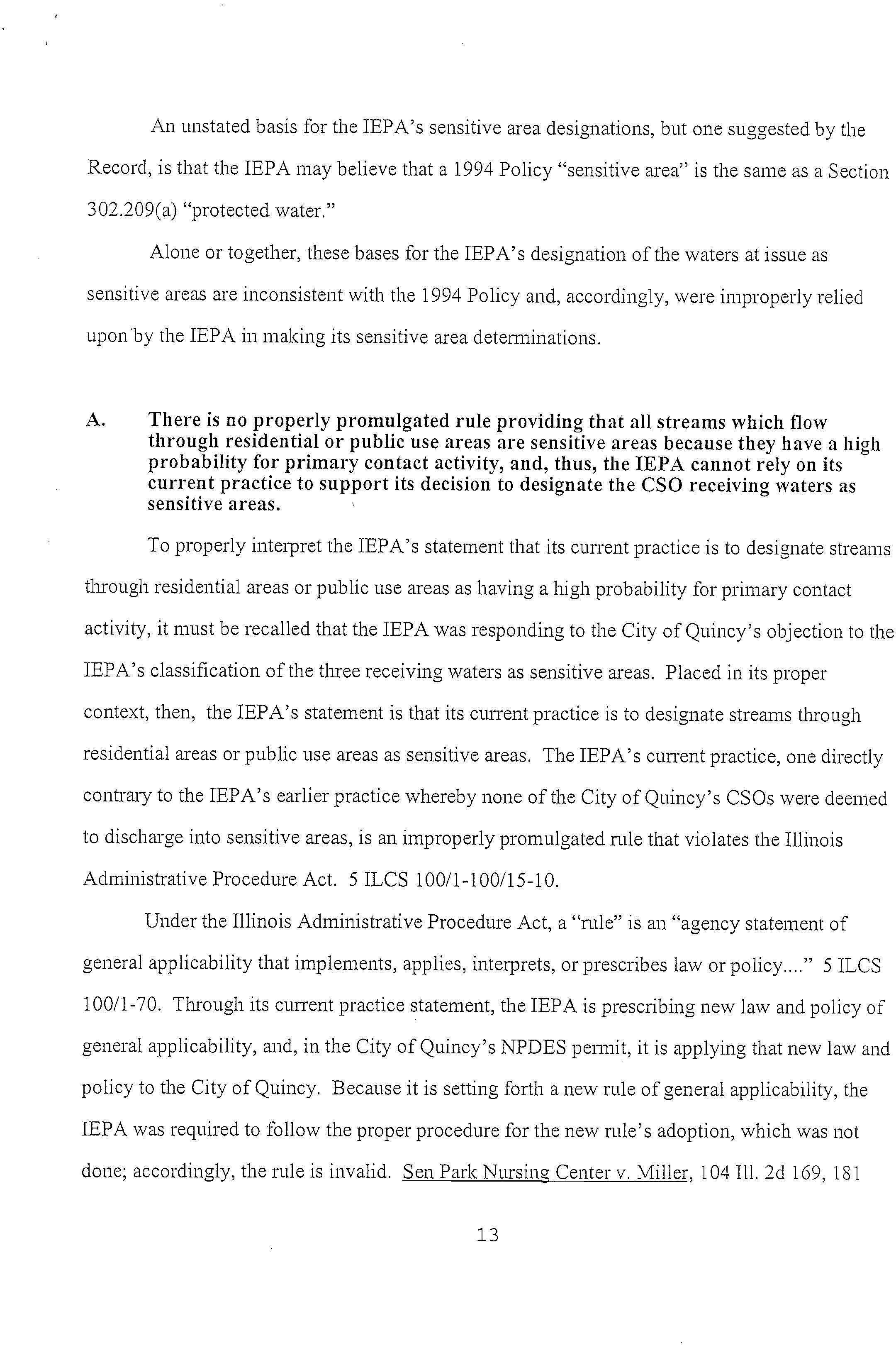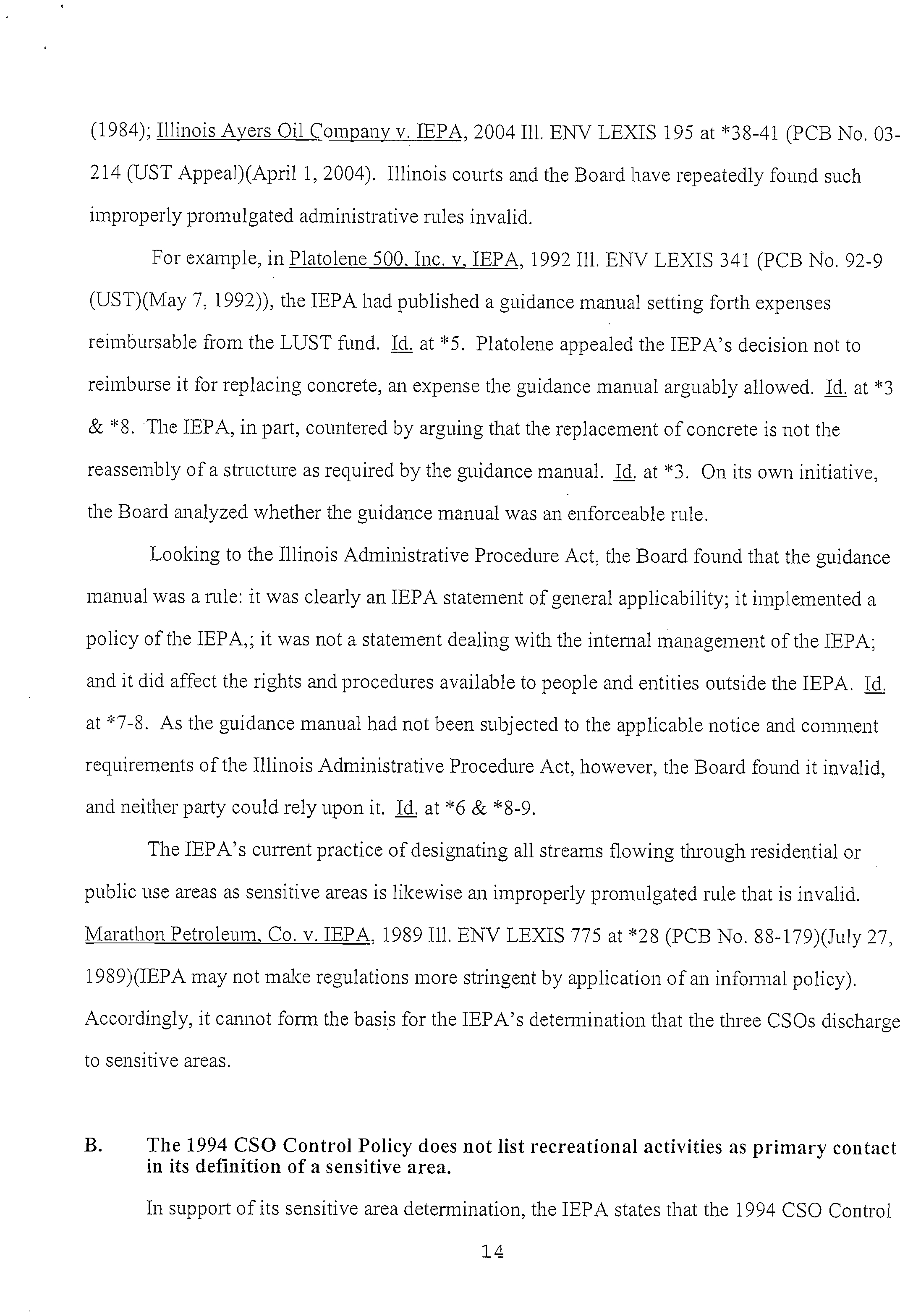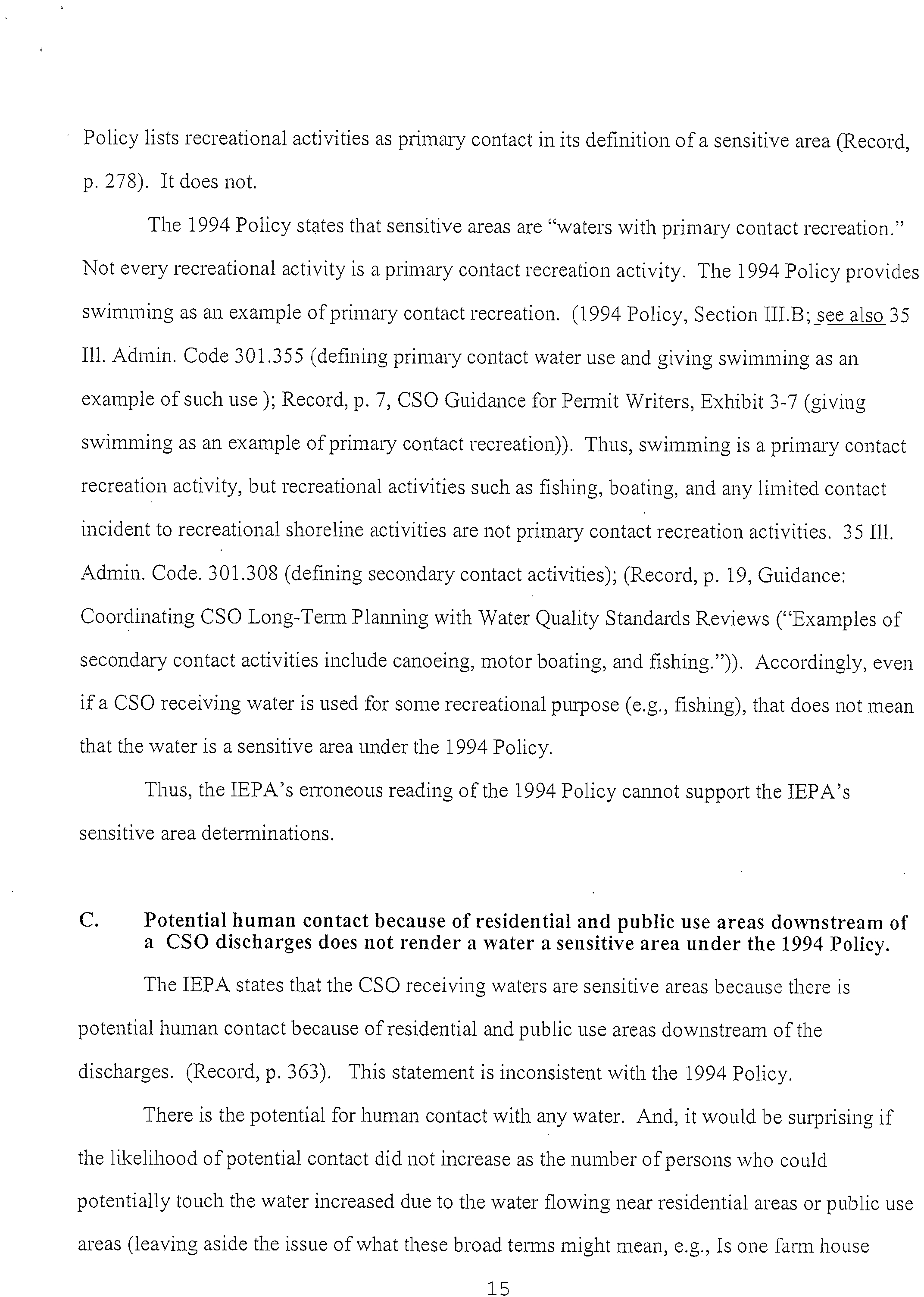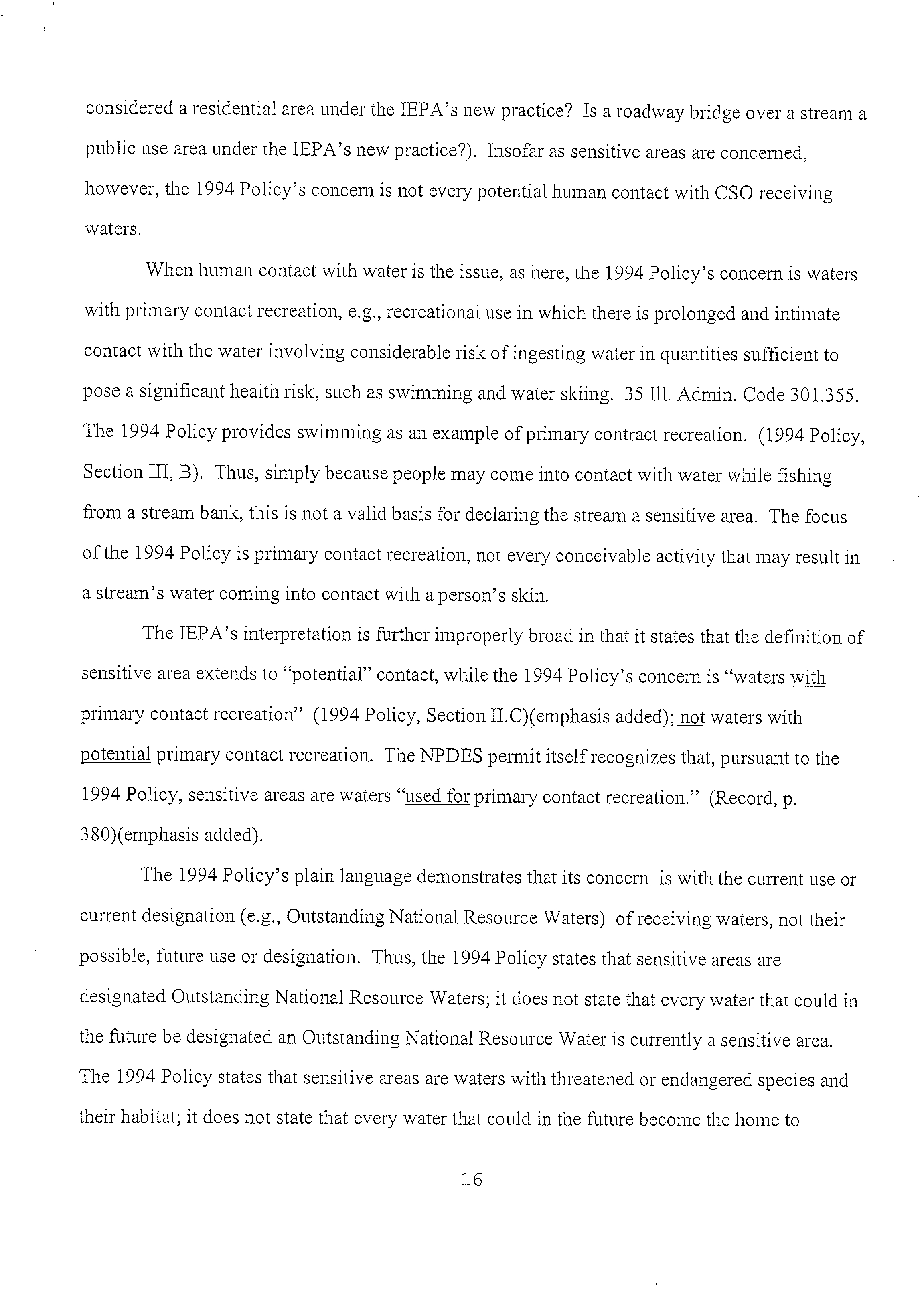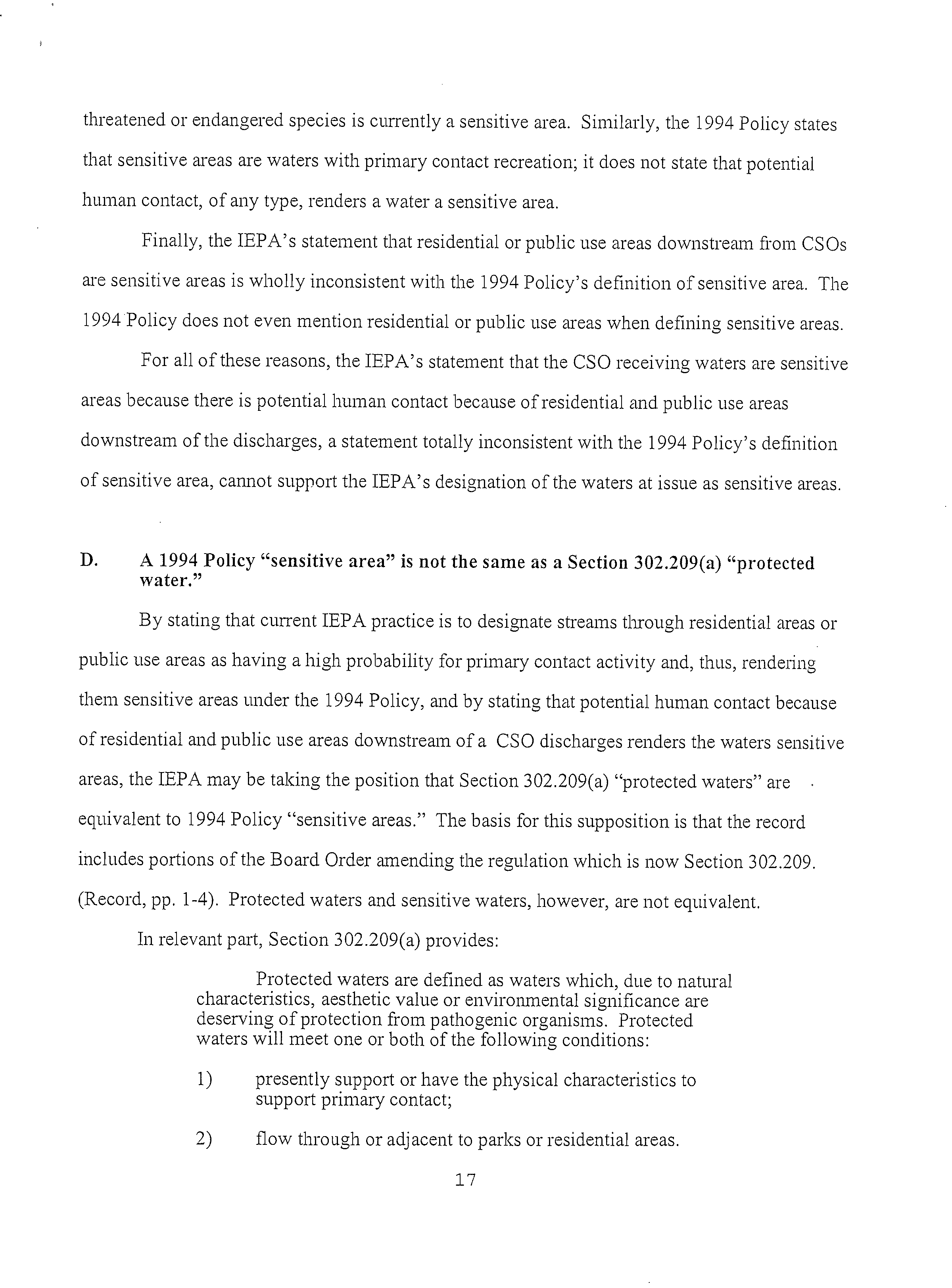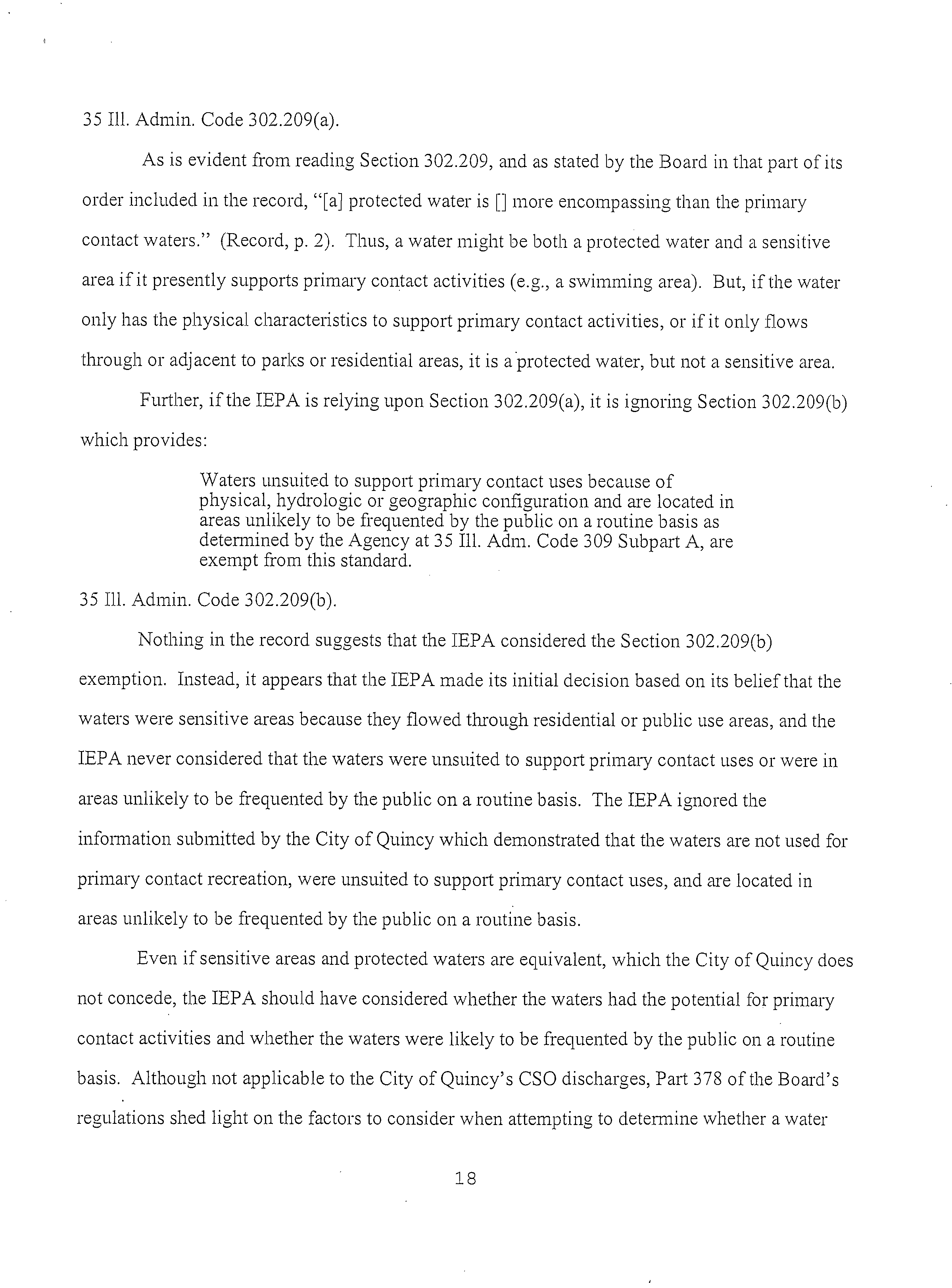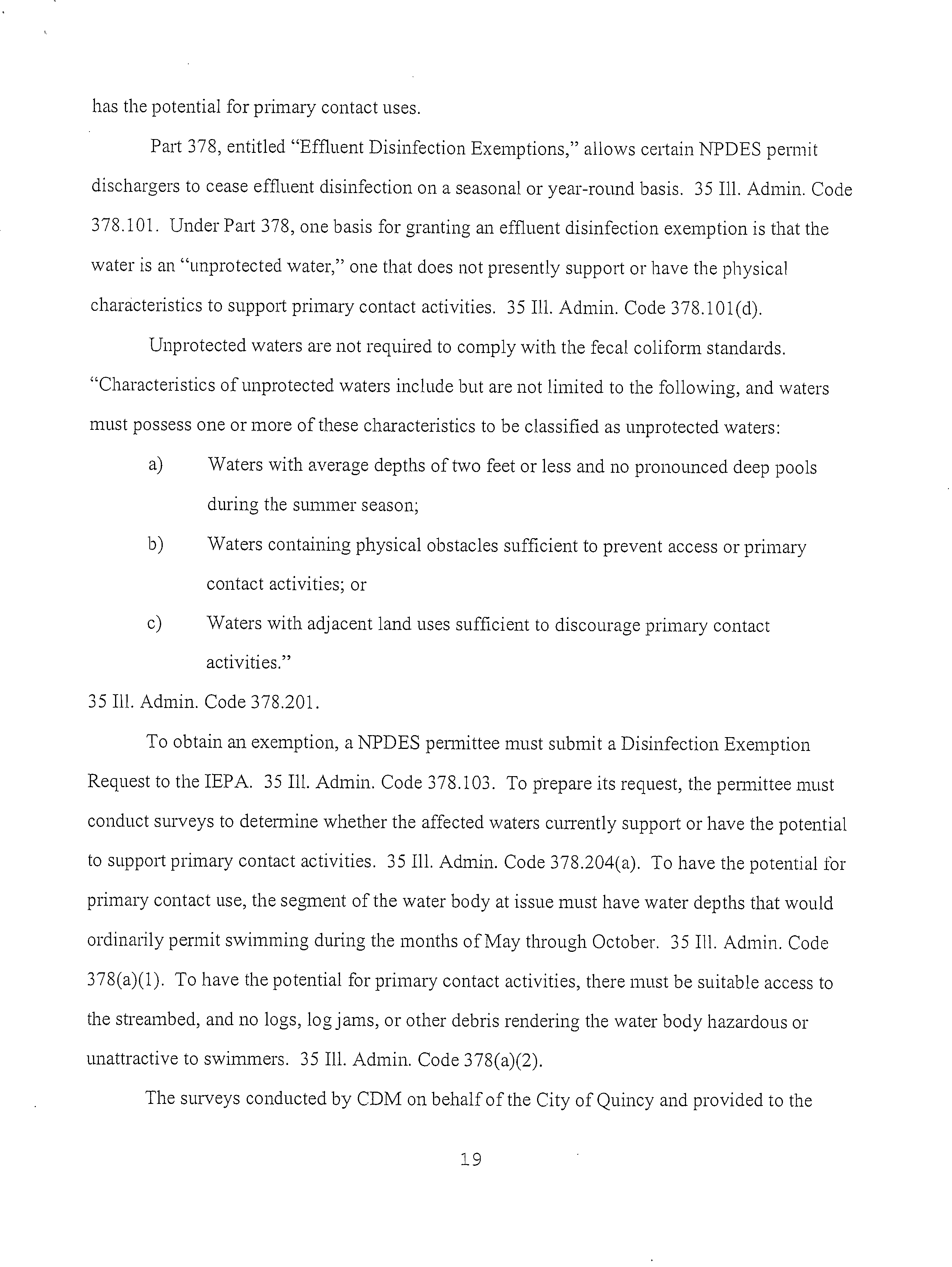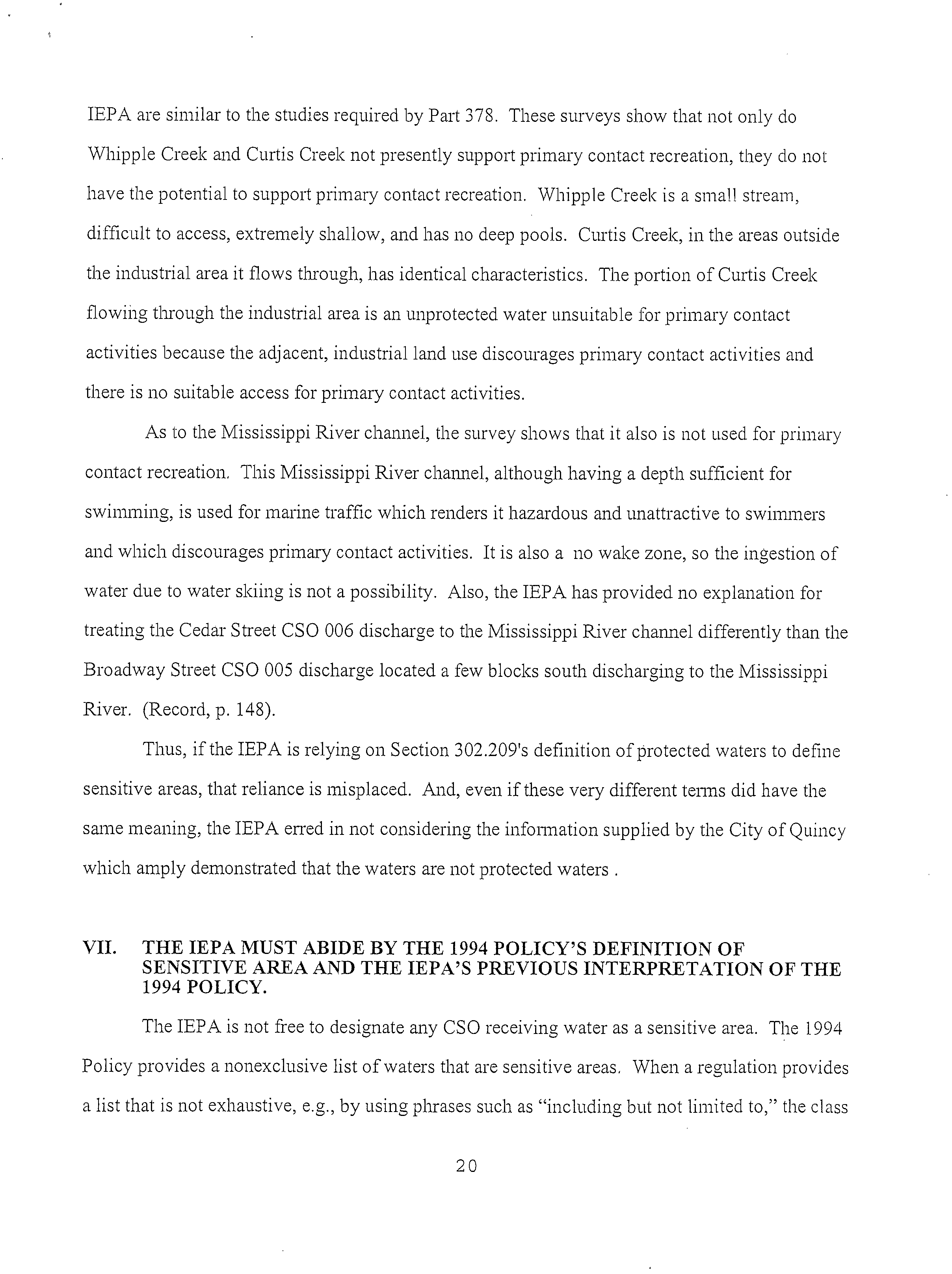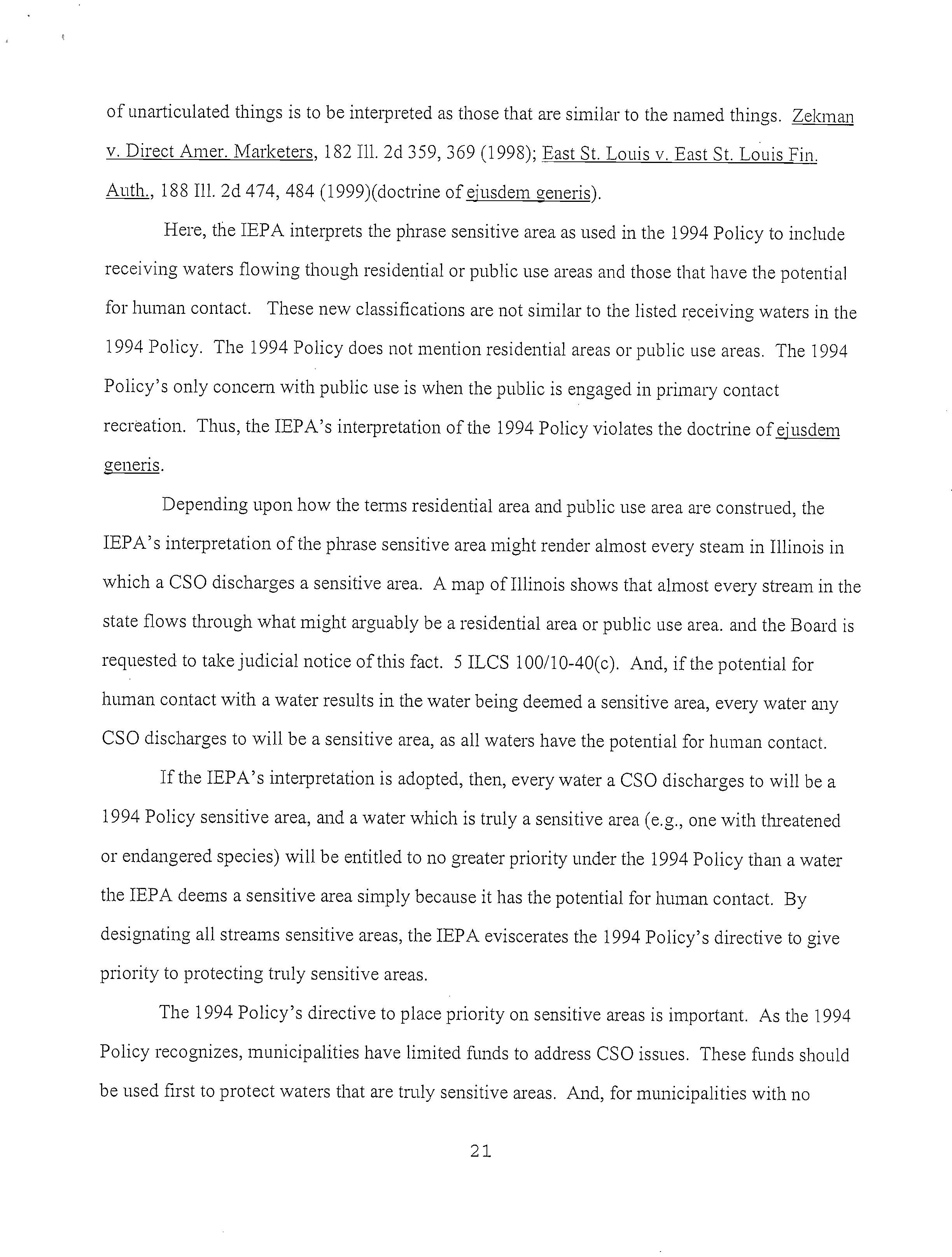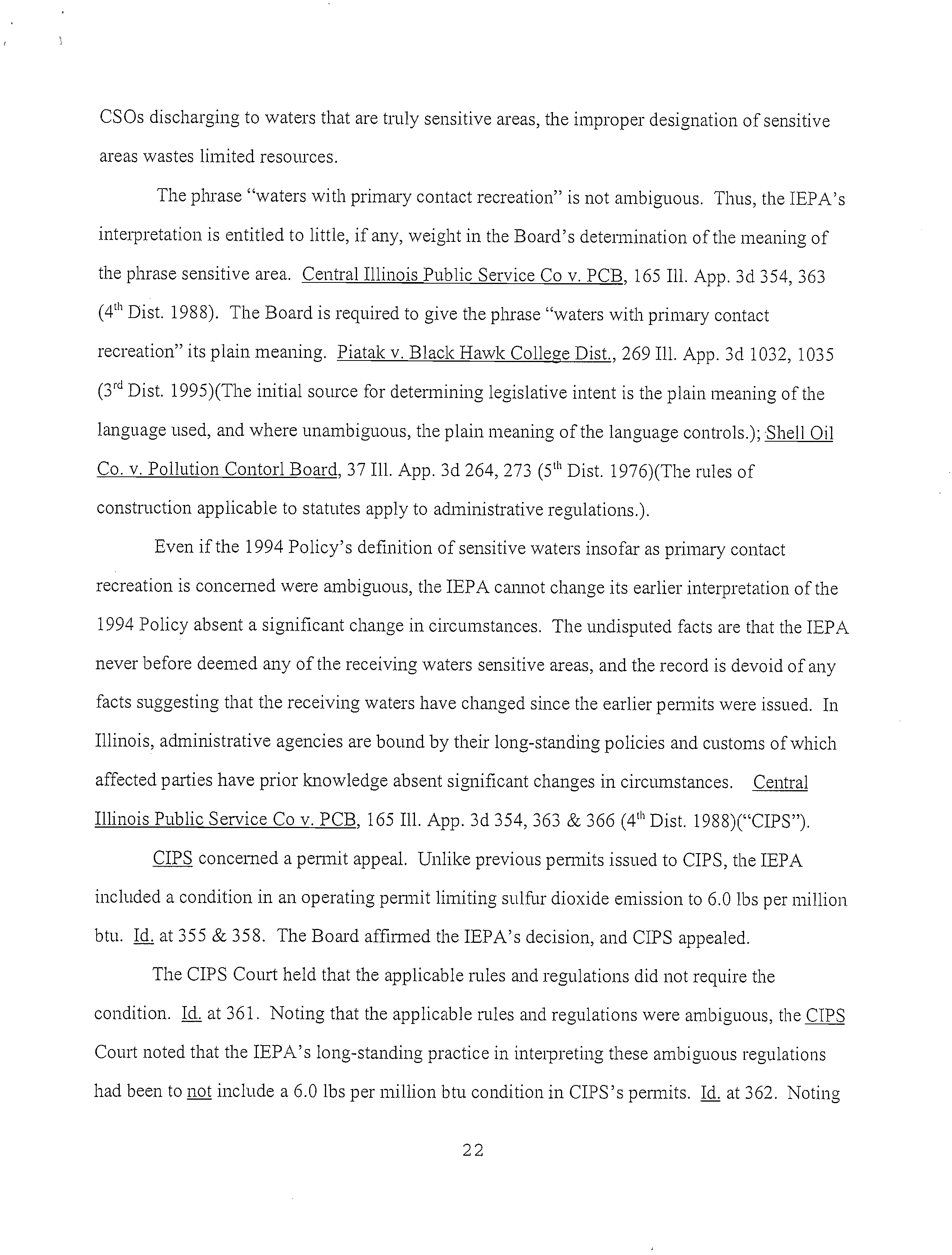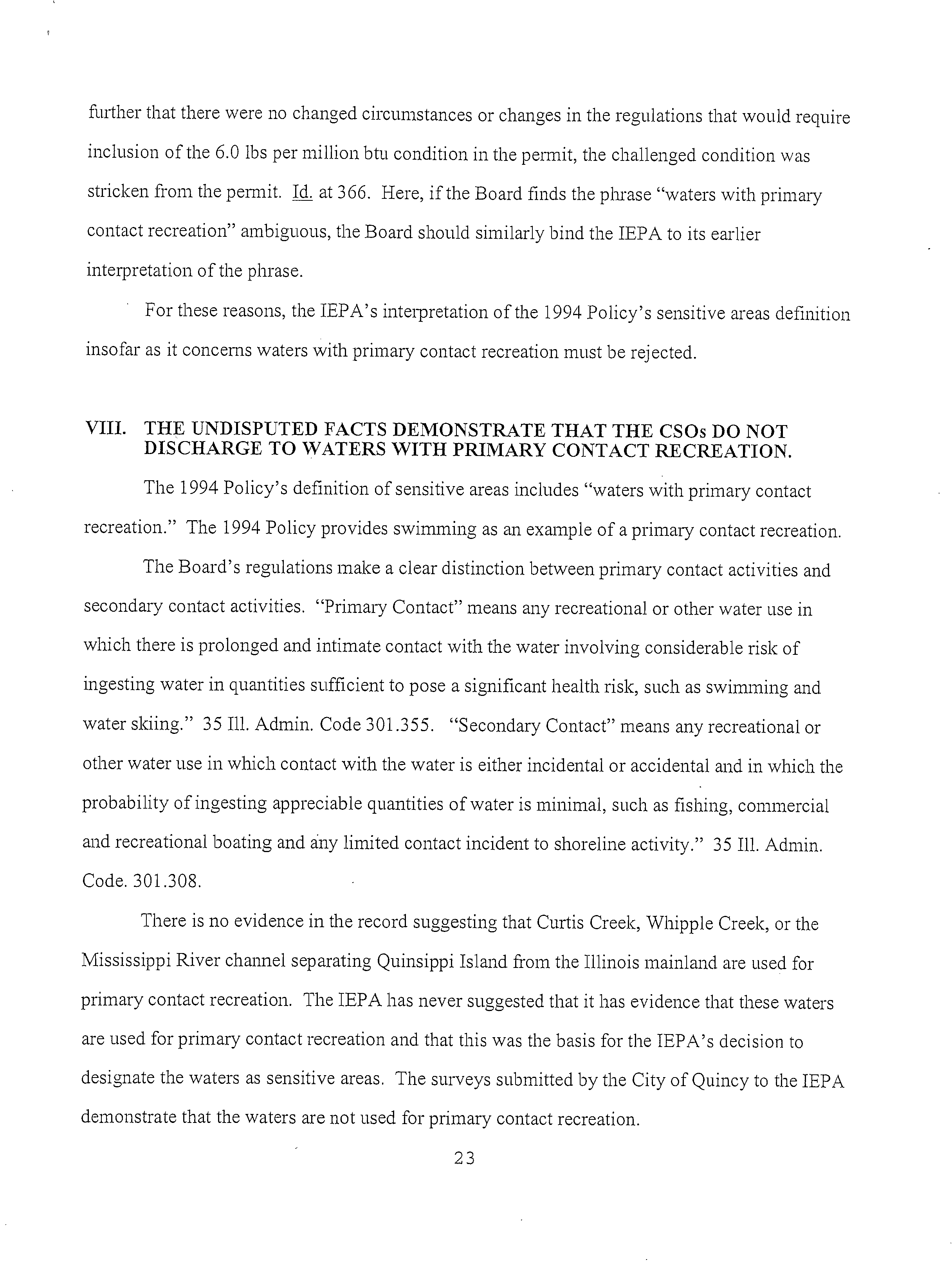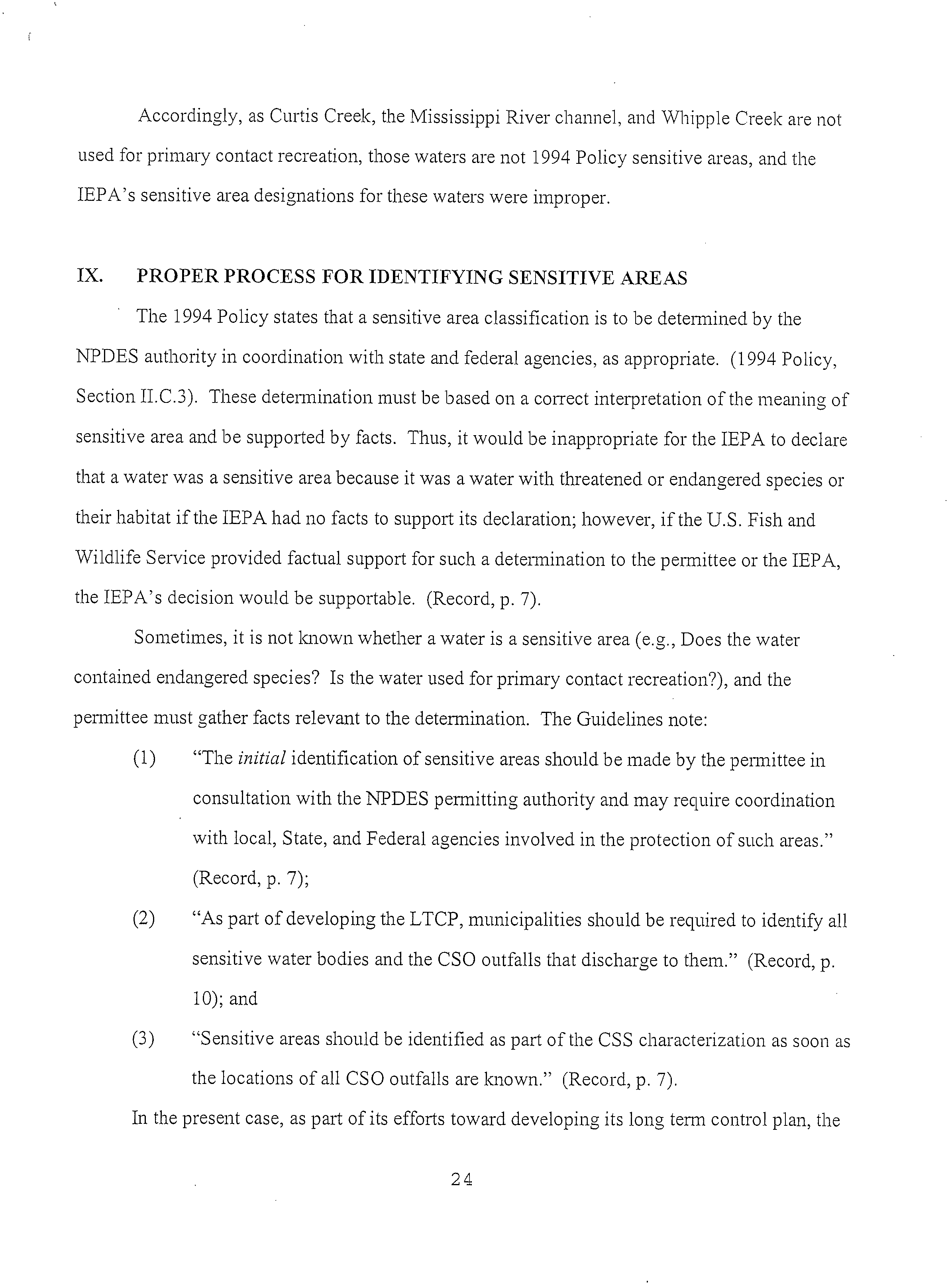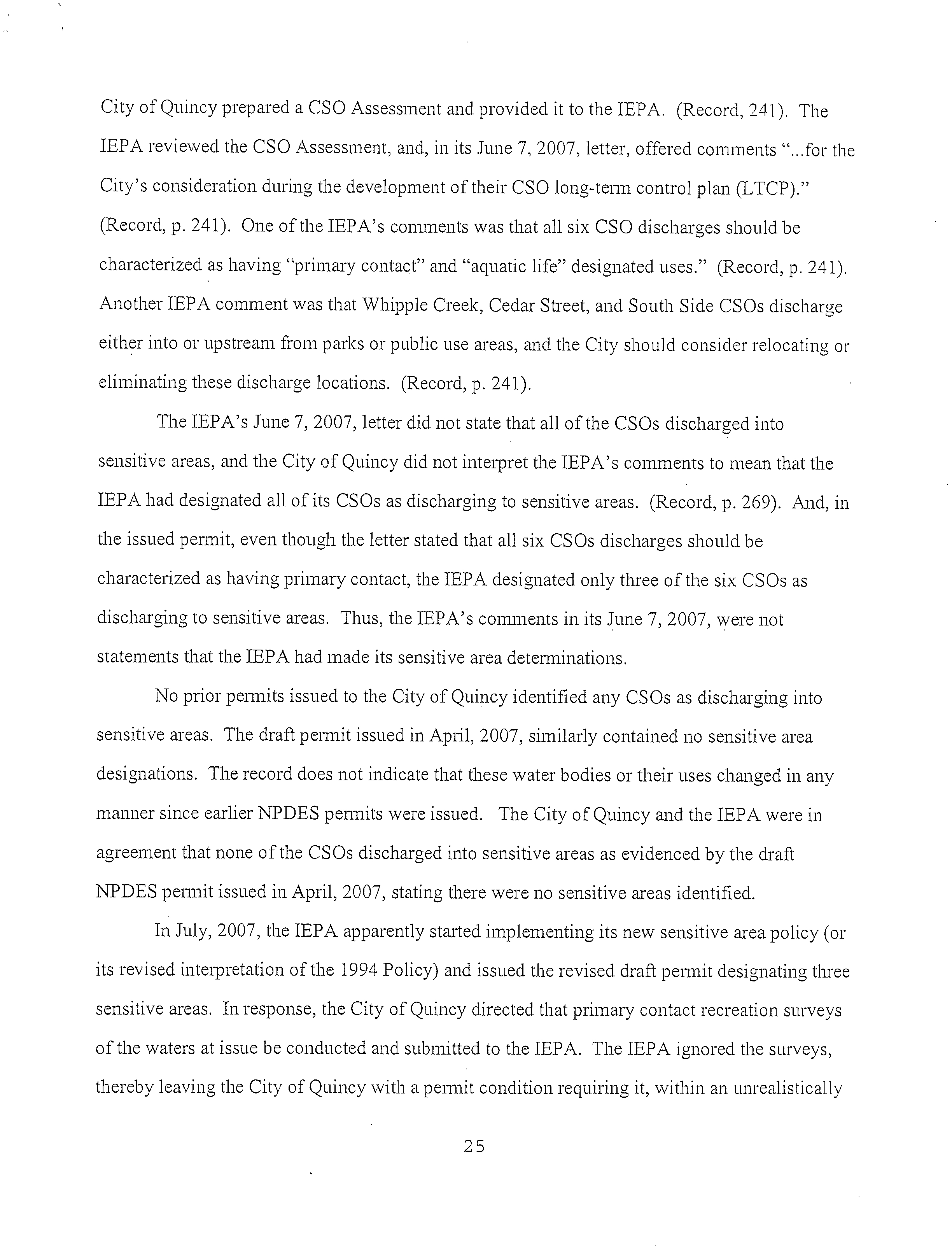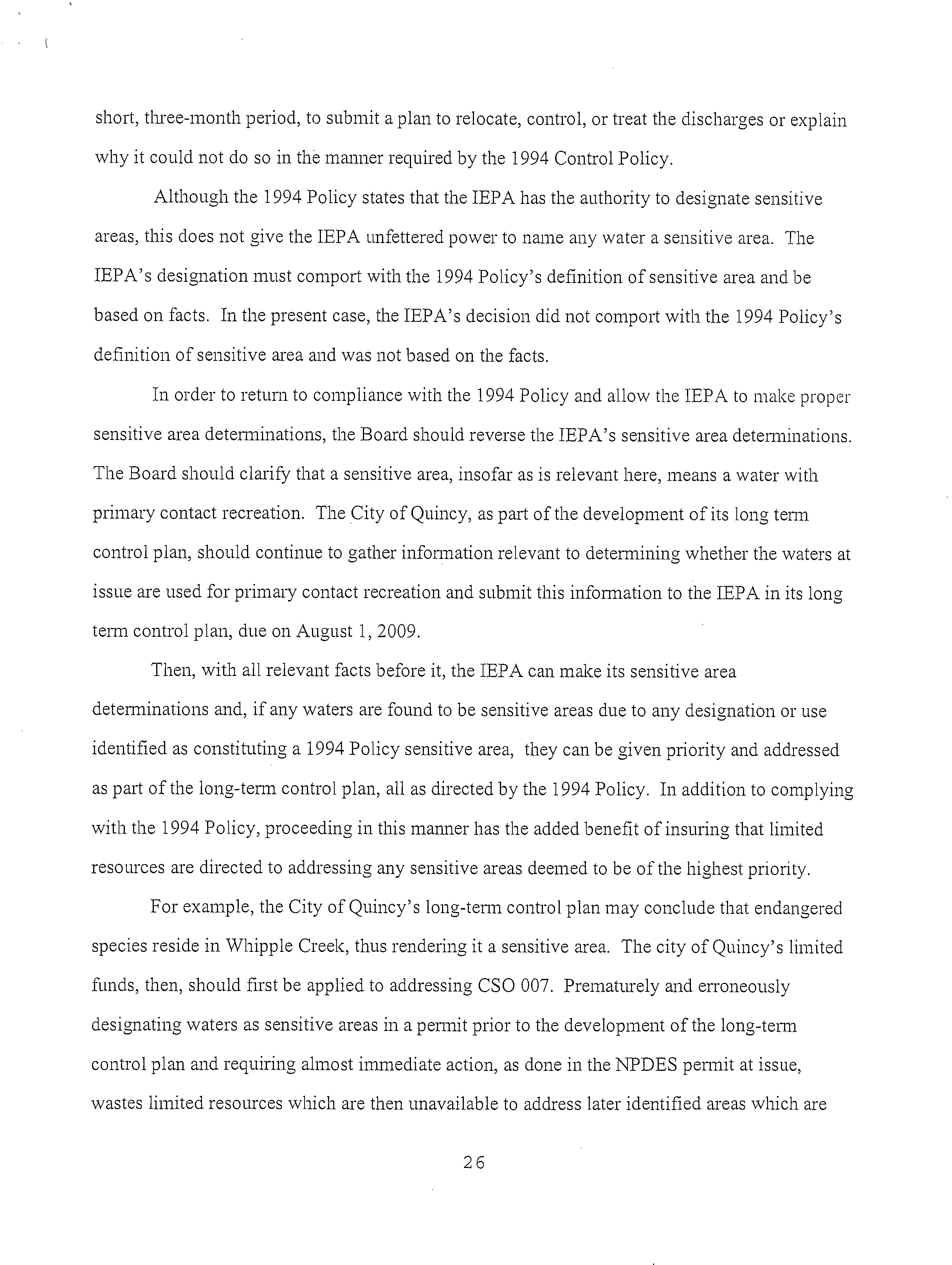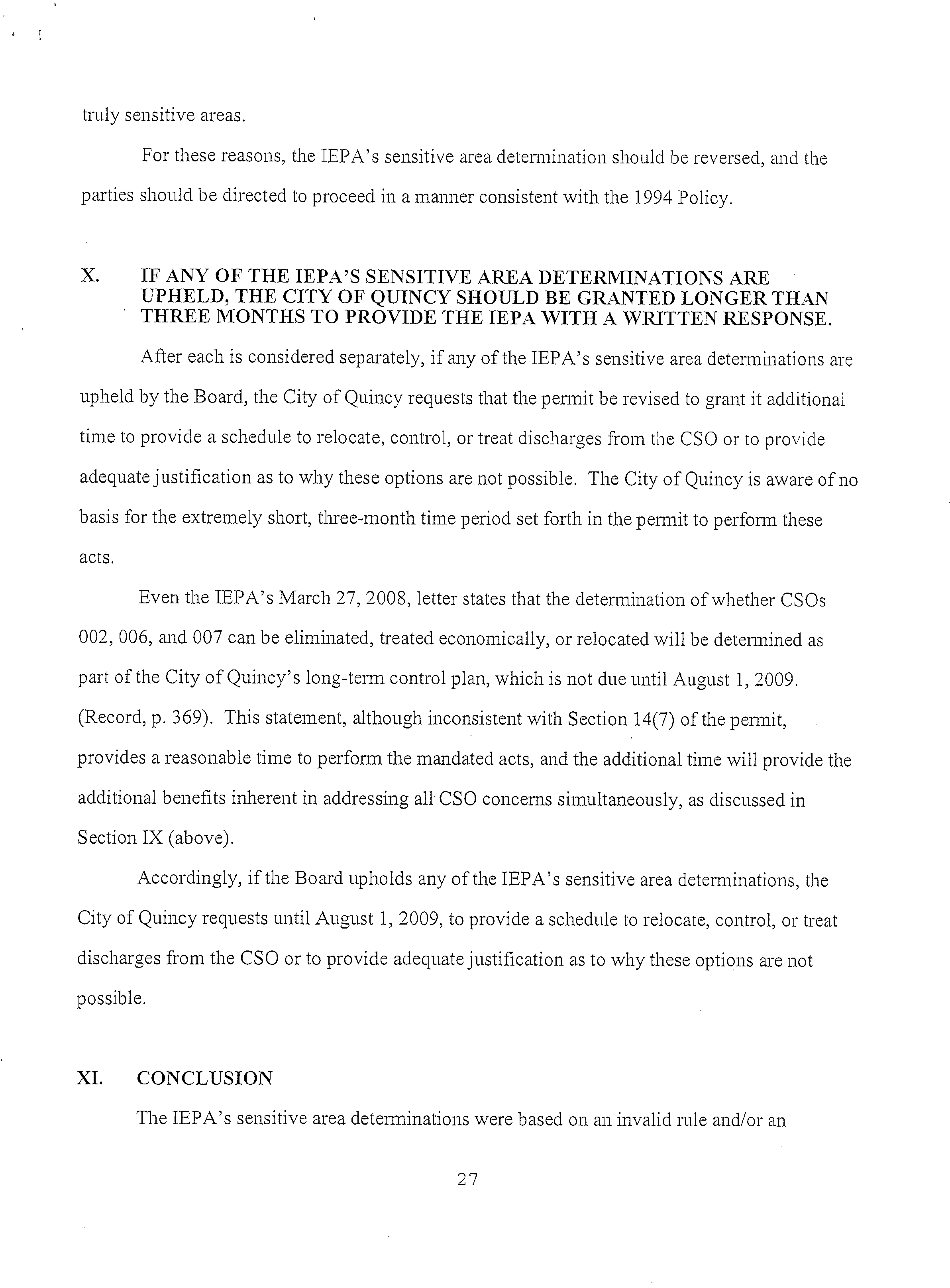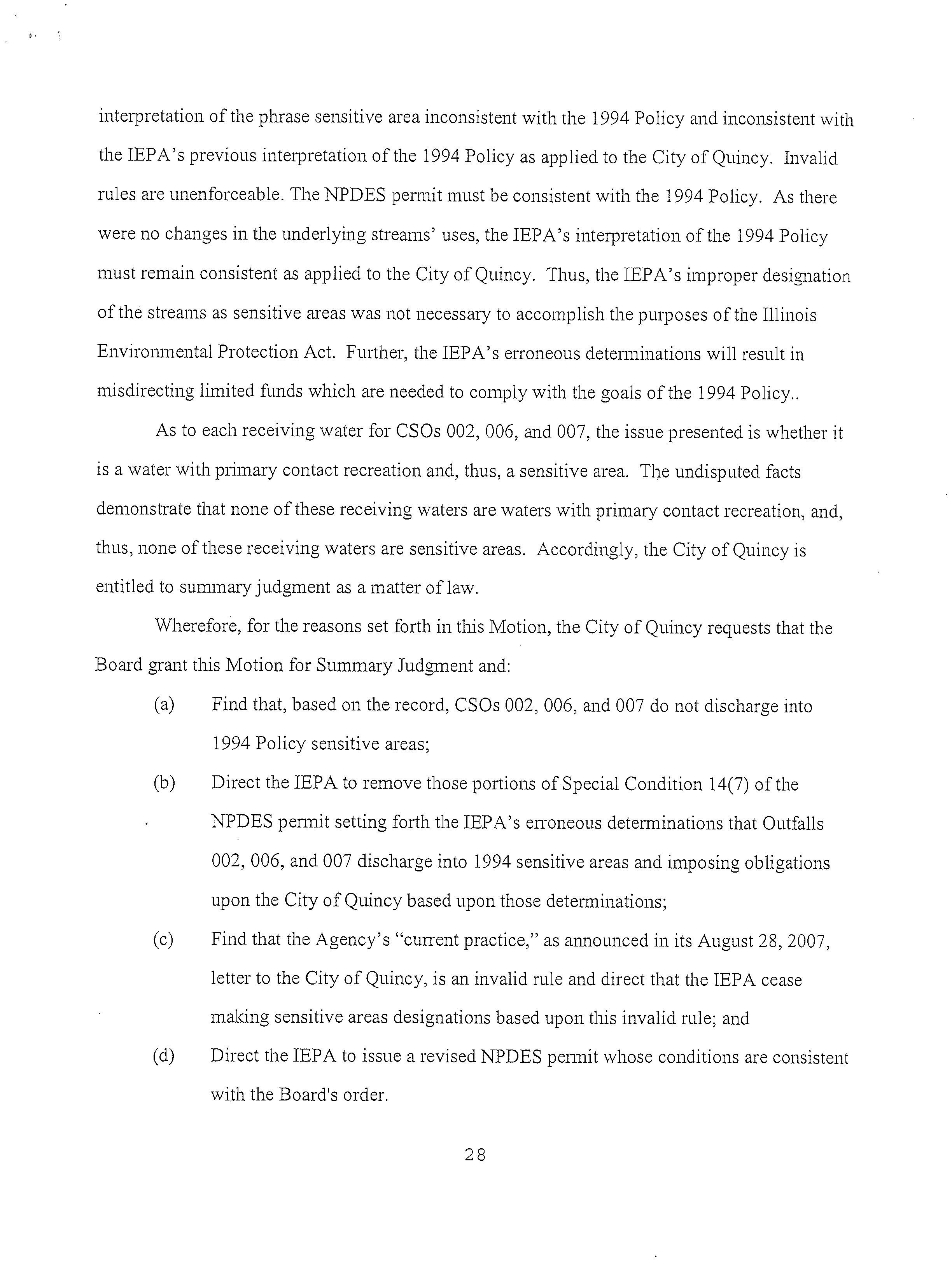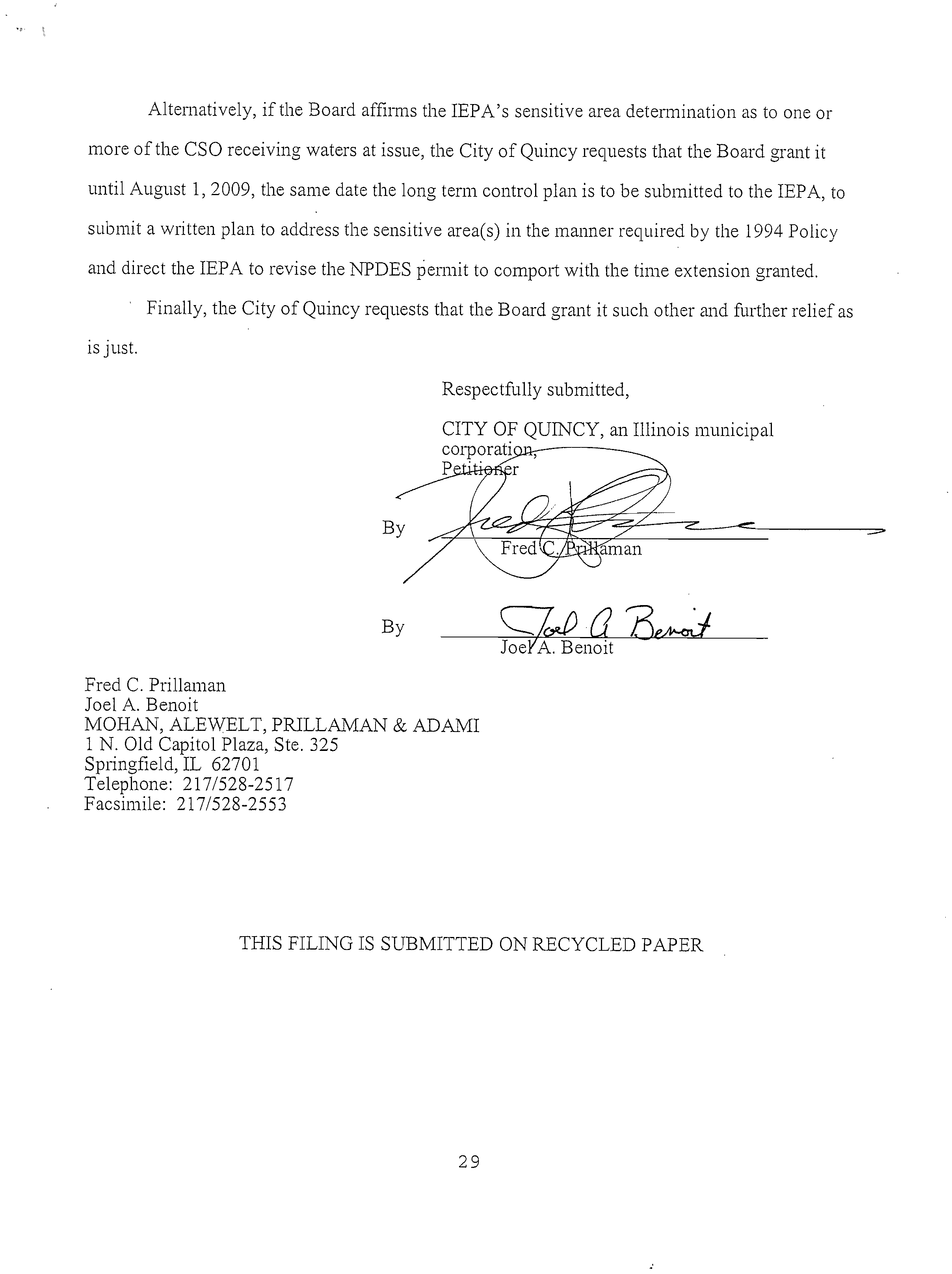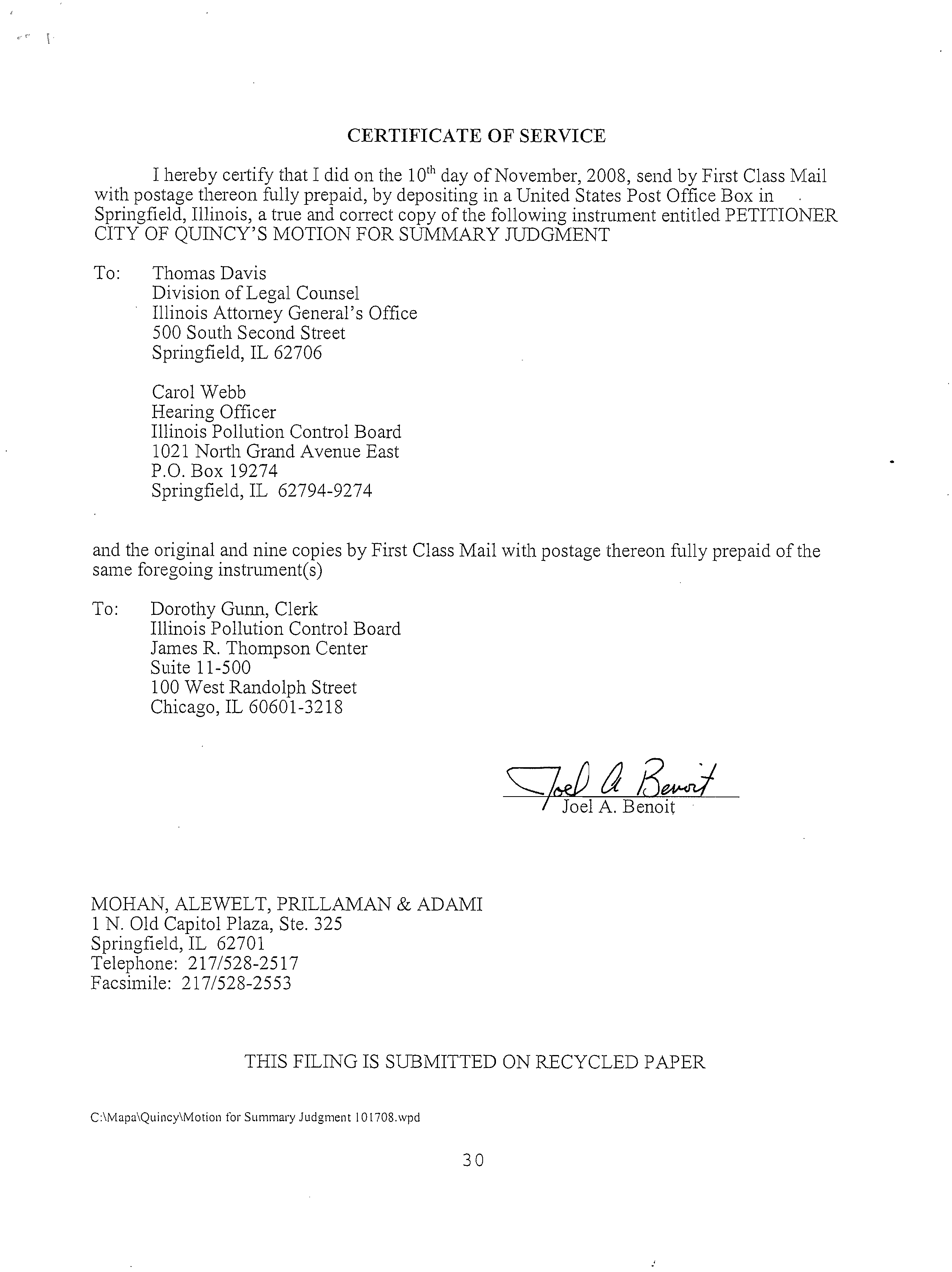BEFORE
THE
ILL1NOIS
POLLUTION
CONTROL
BOARD
NOTICE
OF
FILING
S
IUtioI
7
f’v0
15
Appeal)
To:
Thomas
Davis
Division
of
Legal
Counsel
Illinois
Attorney
General’s
Office
500
South
Second
Street
Springfield,
IL 62706
Carol
Webb
Hearing
Officer
Illinois
Pollution
Control
Board
1021
North
Grand
Avenue
East
P.O. Box
19274
Springfield,
IL
62794-9274
PLEASE
TAXE
NOTICE
that
on the
10
day of November,
2008,
I mailed
the
following
document
for
filing with
the
Clerk
of the
Pollution
Control
Board
of
the
State
of
Illinois:
Petitioner
City
of Quincy’s
Motion
for Summary
Judgment
a copy
of which
is
attached
hereto
and
herewith
served
upon
you.
Fred
C.
Prillaman
Joel
A.
Benoit
MOHAN,
ALE
WELT,
PRILLAMAN
& ADAMI
1
N.
Old Capitol
Plaza,
Ste.
325
Springfield,
IL
62701
Telephone:
217/528-2517
Facsimile:
217/528-2553
CITY
OF
QUINCY,
an
Illinois
municipal
)
corporation,
)
)
Petitioner,
)
)
v.
)
)
ILLINOIS
ENVIRONMENTAL
)
PROTECTION AGENCY,
)
)
Respondent.
)
PCB
No.
08-86
(NPDES
Permit
CITY
OF
corp
1
By
Joel
A.
Benoit
BEFORE
THE
ILLINOIS
POLLUTION
CONTROL
BOARD
CITY
OF
QUINCY,
an
Illinois
municipal
)
corporation,
)
Petitioner,
)
?2fln.
p
0111
v.
)
PCB
No.
08-86
;
)
(NPDES
Permii
Appa1)
ILLINOIS
ENVIRONMENTAL
)
PROTECTION
AGENCY,
)
)
Respondent.
)
PETITIONER
CITY
OF
QUINCY’S
MOTION
FOR
SUMMARY
JUDGMENT
NOW
COMES
Petitioner
City
of Quincy,
by
and
through
its
attorneys,
Mohan,
Alewelt,
Prillarnan
&
Adarni,
and
respectfully
submits
this
Motion
for
Summary
Judgment, filed
pursuant
to
35
Ill. Admin.
Code
101.5
16,
for
the
Illinois
Pollution
Control Board’s
consideration.
I.
INTRODUCTION
The
City
of
Quincy
operates
a
combined
sewer
system
and
a
wastewater
treatment
facility.
The
combined sewer
systcm
includes
six
combined sewer
overflows
(CSOs).
The
Illinois
Environmental
Protection
Agency
(IEPA)
issued
the
City
of
Quincy
a
NPDES
permit
effective April
1,
2008,
which,
in
part,
governs
discharges
from
these
CSOs.
Special
Condition
14(7)
of
the
NPDES pennit
states
that
the
IEPA
has
determined
that
three
of
the
CSOs
discharge
into
“sensitive
areas”
(as
that
phrase
is
used
in
the
1994
Federal
CSO
Control
Policy)
and
requires
the
City
of Quincy,
within
three
months
of
the
effective
date
of
the
permit,
to provide the
IEPA
with
a schedule
to
relocate,
control,
or
treat
discharges
from
the
three
CSOs
or provide
adequate
justification
as to
why
the
options
are
not
possible.
Through
this
appeal,
the
City
of
Quincy
seeks
the
removal
of these
conditions
from
the NPDES
permit.
1
II.
STANDARD
OF REVIEW
FOR MOTIONS
FOR
SUMMARY
JUDGMENT
Summary
judgment
is appropriate
when the
pleadings,
depositions,
admissions
on
file,
and affidavits
disclose
that
there is no
genuine
issue as
to any
material
fact and
the
moving
party
is
entitled
to judgment
as a matter
of law.
Dowd
&
Dowd,
Ltd. v.
Gleason,
181 Ill.
2d 460, 483
N.E.2d
358,
370
(1998).
In
ruling
on
a
motion
for summary
judgment,
the
Board “must
consider
the
pleadings,
depositions,
and
affidavits
strictly
against
the movant
and in favor
of
the
opposing
party.”
IcL
Summary
judgment
“is
a
drastic
means
of disposing
of
litigation,”
and
therefore
shoLLid
be
granted
only
when the movant’s
right
to the
relief “is clear
and
free
from doubt.”
Id, citing
Purtill
v.
Hess, 111
Ill.2d
299, 240,
489
N.E.
2d
867, 871
(1986).
However,
a party
opposing
a motion
for summary
judgment
may
not
rest
on its
pleadings,
but
must
“present
a factual
basis which
would
arguably
entitle [it]
to a judgment.”
Gauthier
v.
Westfall,
266
Ill.
App. 3d
213,
219,
639
N.E.2d
994,
999
(2dDist.
1994).
Jersey
Sanitation
Con.
vs.
IEPA,
PCB
No.
00-82,
p.
5
(June 21,
2001)(Permit
Appeal-Land).
III.
BURDEN
OF PROOF
IN PERMIT
APPEAL
The Illinois
Environmental
Protection
Act
• . states
that
when granting
permits, the
IEPA “may
impose
such
conditions
as
may
be
necessary
to accomplish
the
purposes
of this Act,
and
as are
not
inconsistent
with
the
regulations
promulgated
by the Board
hereunder.”
415
ILCS
5/39(a)
(West
2000). To
prevail
on its
claim,
the petitioner
must
show
the
IEPA’s
imposed
modifications
“were
not necessary
to accomplish
the
purposes
of
the Act,
or stated
alternatively,
[the
petitioner]
had
to
establish
that
its plan would
not
result
in any
future
violation
of the Act
and the
modifications,
therefore,
were
arbitrary
and
unnecessary.”
Brownin-Feffis,
179 Iii. App.
3d at
603,
534 N.E.2d
at 620.
IEPA
v.
Jersey Sanitation
Corp.,
336 Ill.
App.
3d
582, 593
(4t1
Dist. 2003);
see also
Noveon,
Inc.
v.
IEPA, 2004
Ill.
ENV
LEXIS 511
at
*15
(PCB
No. 91-17)
(September
16, 2004).
Once
a
perrnittee
establishes
a prima
facie
case
that a permit
condition
is umecessary,
it
is
incumbent
upon the
IEPA to
refute the
prima facie
case.
John Sexton
Contractors
Co.
v.
PCB,
201 Ill.
App.
3d 415,
425
(
4
th
Dist.
1990).
The
ultimate
burden
of proof,
however,
remains
with
the permittee.
2
IV.
Ui’
DISPUTED
FACTS
A.
The
City
of
Quincy’s
CSOs.
The
City
of
Quincy’s
combined
sewer
system
and
wastewater
treatment
facility
serves
49,250
people.
(Record,
p.
38).
The
combined
sewer
system
includes
six CSOs.
(Record,
pp.
136-147).
The
City
of
Quincy’s
CSOs
are
generally
identified
as follows:
Discharge
Number
Location
Receiving
Water
002
South
Side
CSO
Curtis
Creek
003
Jefferson
Street
CSO
Mississippi
River
004
Dicks-Payton
CSO
Mississippi
River
005
Broadway
Street
CSO
Mississippi
River
006
Cedar
Street
CSO
Quincy
Bay
007
Whipple
Creek
CSO
Whipple
Creek
(Record,
p.
233).
CSOs
003,
004,
and
005
are not
at
issue in
this appeal.
B.
Outfall
002—South
Side
CSO
Outfall
002,
the
South
Side
CSO,
discharges
into
Curtis Creek.
(Record,
pp.
136-137).
Outfall
002
is
located
west
of
Eighth
Street
and
south
of
Indian
Mounds
Park.
(Record,
pp.
148,
201,
and 203).
Traveling
generally
west,
the distance
from
Outfall
002 to
Curtis
Creek’s
confluence with the
Mississippi
River
is approximately
5,900
feet.
(Record,
pp.
306,
308 &
313).’
During
an
August,
2007,
survey,
the
wetted
stream
width
of
Curtis
Creek
ranged
from 7
to
60 feet,
with
an
average
width of
3
1.5
feet.
(Record,
pp.
305
&
308).
The
survey
divided
‘As submitted
to
the
IEPA, certain
photographs,
charts,
etc.,
were color
copies.
(Record,
pp.
302-33
1 &
33 8-359).
If this
portion
of
the record
was
not
submitted
in color
to the
Board,
upon
notice,
the
City
of Quincy
will provide
color
copies
to
the
Board.
3
Curtis Creek
into
sampling
locations
(T-j
spaced
300
feet
apart.
(Record,
p.
305). The
upper
portion
of
Curtis
Creek
(approximately
T1-T5)
is densely
populated
by
trees
and
shrubs,
making
access
to
the
creek
difficult.
(Record,
pp.
306,
310
&
313).
The
understory
is
composed
of
herbaceous
vegetation
dominated
by
poison
ivy.
(Record,
p.
310). Over
98%
of
the
stream
bank
in
the
creek’s
upper
reaches
was
rated
difficult
for
access
to
the
creek,
and
moderate
to steep
fbr
bank
slope.
(Record,
p.
310). The
upper
half
of
Curtis
Creek,
having
an
average
depth
of
approximately
6.5
inches,
has
insufficient
depth
and
flow
to
support
recreational
watercraft.
(Record,
p.
309
&
310).
The
lower
portions
of
Curtis
Creek
(approximately
T6-T20)
flow
through
an
industrial
area.
(Record,
pp.
306,
310,
314,
&
329-33
1.)
The
lower
portions
of
Curtis
Creek
are
channelized
and
lined
with
concrete
in
selected
locations
prior
to
its confluence
with
the
Mississippi
River.
(Record,
pp.
3 10-311
&
329-33
1).
The
lower
reach
before
the
confluence
with
the
Mississippi
River
has
steep
banks
that
are
densely
vegetated
with
trees
and
shrubs.
(Record,
p.
311). Back
flow
from
the
Mississippi
River
prevented
water
depth
measurements
in
the
lower
reaches
of
Curtis
Creek, but
the
water
depth
in
the
lower
reaches
was
considerably
higher
than
in
the
upper
reaches.
(Record,
p.
309
(compare
Ti
measurements
to
Ti
1
measurements)
&
311).
No
established
beaches
or
public
access
points
to
the
creek
were
present
along
Curtis
Creek.
(Record,
p.
310).
Evidence
that
primary
contact
recreation
was
occurring,
or
had
occurred,
was
not
observed
in
Curtis
Creek.
(Record,
pp.
310
&
311).
Water
depth
is
not
deep
enough
(excluding
the
lower
reaches
of
Curtis
Creek) to support
swimming
or
any
other
water
activity
that
would
result
in
full
body
immersion.
(Record,
p.
311). “Based
upon
the
physical
and
hydrologic
configuration
of
the
stream
channel
to
support
primary
contact
recreation,
the
probability
that
the
stream is accessed
by
the
public
on
a routine
basis
is
low.”
(Record,
p.
311).
The
IEPA took
photos
of
Outfall 002
on
March
28,
2007.
(Record,
p.
201).
On
October
9,
2007,
the
IEPA
returned
to
take
photos
of
a parking
area
to
the
north
of
Outfall
002,
said
4
parking
area
having
a hiking
trail
leading
north,
apparently
providing
a route
between
the
parking
area
and
Indian
Mounds
Park.
(Record,
pp.
202-203).
C.
Outfall
006—Cedar
Street
CSO
Outfall
006,
the
Cedar
Street
CSO,
is located
in Riverview
Park
in the
northwestern
portion
of
the
city.
(Record,
pp.
148,
204,
205
& 283).
The Cedar
Street
Outfall
006
discharges
directly
into
a
paved
channel
which
carries
any
overflow
approximately
1/4
mile
west
to
its
receiving
water.
(Record,
pp.
148,
204
&
2
12-215).
Approximately
i4
the
length
of
the
paved
channel
travels
through
Riverside
Park.
(Record,
p.
148).
Although
identified
as discharging
into
Quincy
Bay,
(Record,
pp.
144-145),
the
water
discharged
from
the paved
channel
flows
into the
east
side
of the
Mississippi
River
channel
south
of
the
Quinsippi
Island
Bridge.
(Record,
pp.
338,
339,
and
343).
The
Mississippi River
channel
separates
Quinsippi
Island
from
the
Illinois
mainland.
(Record,
p.
343).
Quincy
Bay
itself,
a backwater,
shallow
bay,
begins
approximately
1,800
feet
upstream
of
Outfall
006.
(Record,
p.
338).
The
Mississippi River
channel
was
surveyed
on
September
18,
2007.
(Record,
p.
338).
The northernmost
point
of
the
survey
was near
Cedar
Creek’s
confluence
with
the
Mississippi
River
channel,
and
the
southernmost
point
of the
survey
was
the
southern
tip
of
Quinsippi
Island.
(Record,
p.
339).
Water
depths
are
sufficient
for
boating
in the
western
and middle
portions
of
the
channel.
(Record,
p.
339).
The
conclusions
reached
from
this
survey
are
that
the
existing
uses
of
the
channel
are
primarily
recreational
navigation
and
fishing. (Record,
p.
340).
There
is
a
marina
on
Quinsippi Island
with
approximately
150
boats.
(Record,
p.
340).
Fishing
was
observed. (Record,
p.
339).
Significant
boating
activity
was
observed.
(Record,
p.
339).
There
are
parks
along
the east
side
of
the channel,
but
physical
features
render
the channel
an
unsuitable
place
for
swimming. (Record,
p.
340).
There
are
no
established beaches
or
signs
of primary
5
contact
along
either
bank
of
the channel.
(Record,
p.
339).
During
the survey,
no
primary
contact
activities
were observed,
and there
was
no
evidence
that
they
had
occurred
in the
past.
(Record,
p.
340).
D.
Outfall
007—Whipple
Creek
CSO
Outfall
007
discharges
into
Whipple
Creek.
(Record,
pp.
146-147).
Outfall
007 is
located
in the
northwestern
portion
of
the city,
east
of Fifth
Street
and north
of
Locust
Street.
(Record,
p.
148). From
Outfall
007
to the
end
of
Whipple
Creek
is
approximately
3,330
feet.
(Record,
p.
305).
Whipple
Creek
was
surveyed
in August,
2007.
(Record,
p.
305).
From
Outfall
007
to the
creek’s
termination,
the wetted
steam
width
of
Whipple
Creek
ranges
from
1 to
18
feet,
with
an
average
stream
width
of
8.8 feet.
(Record,
p.
305).
Its
average
depth
is 1.5
inches.
(Record,
p.
305).
The
creek’s
bottom
is
primarily
exposed
bedrock,
with
limited
areas
of cobble
and
gravel.
(Record,
p.
305).
Over
95%
of
the stream
bank
was
rated
difficult
for
access
to the
creek,
and
moderate
to steep
for
bank
slope;
the creek’s
banks
are
densely
populated
by
trees
and
shrubs,
and
the understory
is
composed
of
herbaceous
vegetation
dominated
by poison
ivy.
(Record,
p.
305).
There
was
no
visual
evidence
of
recreation
activity,
past
or
present.
(Record,
p.
308).
Whipple
Creek
is
too shallow
to
support
watercraft,
and there
are
no
beaches
or
public
access
points
on the
creek.
(Record,
p.
308).
The
IEPA
photographed
Outfall
007 on
March
28, 2007;
these
Spring
photographs
show
little
water
in
Whipple
Creek.
(Record,
p.
206).
On
October
9,
2007,
the
IEPA
took
photos
of
a
house
located
near
Whipple
Creek
and
downstream
from Outfall
007.
(Record,
pp.
207-208).
The
caption
of
one photo
states
that
Whipple
Creek
is 30-50
feet
behind
a
trampoline
depicted
in
the
photo
and
that
there
is
no barrier
or
fencing
between
the
trampoline
area
and
Whipple
Creek.
(Record,
p.
208).
6
E.
The
Permitting
Process
No
prior
NPDES permit
issued
to
the
City
of
Quincy
has
ever
included a
determination
that
any
of its
CSOs
discharged
to
sensitive
areas.
(Record,
p.
300).
In
July,
2006,
the
City
of
Quincy
sent
the
IEPA
a
NPDES
permit
renewal
application.
(Record,
p.
21).
On
April
10,
2007,
the
IEPA
mailed
the
City
of Quincy’s
draft
NPDES
permit
and
public
notice/fact
sheet
to
the
USEPA. (Record,
p.
220).
Like
all
previous
permits, Special
Condition
14(7)
of the
draft
permit
states
that
the
IEPA
had
tentatively
determined
that
none
of
the
CSOs
discharged
into
sensitive
areas.
(Record,
p.
234).
Special
Condition
14(10)
of the
draft
permit
requires
the
City
of
Quincy
to
develop
a
Long-Term
CSO
Control
Plan
(“LTCP”)
within
24
months
of
the
effective
date
of
the
permit.
(Record,
pp.
236-237).
When
developing
its
LTCP,
the
draft
permit
required
the
City
of
Quincy
to
consider
sensitive
areas,
as
required
by
the
1994
Federal
CSO
Control Policy.
(Record,
p.
236).
On
April
20,
2007,
the
City
of
Quincy
mailed
IEPA
a
letter
commenting
on
the
draft
permit.
(Record,
pp.
243-244).
On
June
7,
2007,
IEPA
Field
Operations
Section
mailed
a
letter
to
CDM,
the
City
of
Quincy’s
engineers, concerning
its
review
of
a September
11,2006,
CSO
Assessment
prepared
by
CDM
for
the
City
of
Quincy
and
offering
comments
“...for
the
City
consideration
during
the
development
of
their
CSO
long-term
control
plan
(LTCP).” (Record,
p.
241).
Without
setting
forth
supporting
facts,
the
letter
states
that
all of
the
receiving
streams
to
which
the
City
of
Quincy’s
CSOs discharge
should
be
characterized
as
having
primary
contact
and
aquatic
life
designated
uses.
(Record,
p.
241).
The
letter
further
states:
“Whipple
Creek,
Cedar
Street
and
South
Side
CSOs
discharge
either
into
or
upstream
from
parks
or
public
use
areas.
The
City
should
consider
relocating
or
eliminating
these
discharge
locations.”
(Record,
p.
241).
The
letter
concludes
by
listing
the
elements
that
should
be
included
in
the
City
of
Quincy’s
development
of
its
LTCP,
including
the
consideration
of sensitive
areas.
(Record,
p.
242).
7
A meeting
was
held
between
IEPA,
CDM,
and
the
City
of
Quincy
on
July
12,
2007,
during
which
the topic
of
sensitive
areas
was
discussed.
(Record,
p.
268).
During
the
meeting,
it
was
agreed
that
none
of
the
City
of Quincy’s
CSOs
discharged
to
sensitive
areas,
but
that
the
City
of
Quincy
woLild
place
special
emphasis
on
CSO
controls
for
oLttfalls
002,
006,
and
007
when
developing
its
long-term
control
plan.
(Record,
p.
268).
On
July
31,
2007,
the
JEPA
sent
a revised
draft
permit,
public
notice
/fact
sheet
along
with
a cover
letter
to
the City
of
Quincy.
(Record,
pp.
245-267).
The
cover
letter
notes
that
Special
Condition
14(7)
had
been
changed
to
state
that
outfalls
002,
006,
and 007
discharge to
sensitive
areas.
(Record,
p.
245).
In
the
revised,
draft
permit,
Section
14(7)
states:
Pursuant
to
Section
II.C.3
of
the
federal
CSO
Control
Policy
of
1994,
sensitive
areas
are
any water
likely
to
be
impacted
by
a
CSO
discharge
which
meet
one or
more
of the
following
criteria:
(1)
designated
as an
Outstanding National
Resource
Water;
(2)
found
to contain
shellfish
beds;
(3) found
to contain
threatened
or
endangered
aquatic
species
or
their
habitat;
(4)
used
for
primary
contact
recreation;
or, (5)
within
the
protection
area
for
a drinking water
intake
structure.
The
IEPA
has
determined
that
outfall(s)
002,
006
and
007
discharge
to
sensitive
area(s).
Within
three
(3)
months
of the
effective
date
of
this
Permit,
the Permittee
shall
submit
two
(2)
copies
of
either
a
schedule
to
relocate,
control,
or
treat
discharges
from
these
outfalls.
If none
of these
options
are
possible,
the
Permittee
shall
submit
adequate
justification
as to
why
these
options
are
not possible.
Such
justification shall
be in
accordance
with Section
II.C.3
of
the National
CSO
Control
Policy.
The
IEPA
has
determined
that
none
of
the
other
outfalls
listed
in
this
Special
Condition discharge
to
sensitive
areas.
However,
if information
becomes
available
that
causes
the
IEPA
to
reverse
this
determination,
the IEPA
will
notify
the Permittee
in
writing.
Within
three
(3)
months
of
the date
of
notification
or
other
date contained
in
the
notification
letter,
the
Permittee
shall
submit
two
(2) copies
of either
a
schedule
to
relocate,
control,
or
treat
discharges
from
these
outfalls.
If
none
of
these
options
are
possible,
the
Permittee
shall
submit
adequate
justification
at
that
time
as to
why
these
options
are
not
possible.
Such
justification shall
be
in accordance with
Section
II.C.3
of
the National
CSO
Control
Policy.
(Record,
p.
261).
On
August
8,
2007,
the City
of
Quincy
mailed
a
letter
to
the
IEPA
objecting
to
the
sensitive
areas
designations in the
revised,
draft
pennit.
(Record,
p.
268).
The
letter
states
that
these
designations were
contrary
to the
agreement
reached
at
the
July
12,
2007,
meeting,
during
which
it
was
agreed
that
none
of
the
CSOs
discharged
into
sensitive
areas,
but
that
the
City
of
8
Quincy
would
place
emphasis
on CSO
controls
at
CSOs
002,
006,
and
007.
(Record,
p.
268).
On
August
28,
2007,
the
JEPA
responded
to
the
City
of
Quincy’s
objection
to
the
designation
of the
three
CSOs
as
discharging
to sensitive
areas.
(Record,
p.
278).
The
IEPA
did
not
disagree
that,
at
the
July
12,
2007,
it was
agreed
that
none
of
the
CSOs
discharged
into
sensitive
areas,
but
instead
stated:
Current
Agency
practice
is
to designate
streams
through
residential areas
or
public
use
areas
as
having
a high
probability
for
primary
contact
activity. Additionally,
the
1994
CSO
Control
Policy
lists
recreational
activities
as primary
contact
in
its
definition
of
a
sensitive
area.
The
Agency
modified
the
Permit
to
indicate
that
outfalls
002,
006
and
007
discharge
to sensitive
areas
because
of the
above
stated
reasons.
Item
7
of
Special
Condition
14
of
the Permit gives
the
Perrriittee
the
right
to
submit
evidence
to
challenge
this
determination.
(Record,
p.
278)(emphasis
added).
On
September 13,
2007,
the
City
of
Quincy
mailed
a
letter
to
the IEPA
in which
it
repeated
its
objection
to
the
IEPA’s
sensitive
area
determinations
as being
factually
unsupportable
and
further,
that
these
determinations
would
have
disastrous
financial
implications
for
the
City
of
Quincy.
(Record,
p.
300-301).
Attached thereto
were
cost
estimates
for
terminating discharges
at
CSOs
002,
006,
and
007,
estimates
which
ranged
from
$28
million
to
$139
million.
(Record,
p.
303). Also
attached
was
a
September
11,
2007,
CDM
memo
describing
a survey conducted
to
determine
if any
of
the
CSOs
discharged
into
sensitive
areas
and
concluding
that
they
did
not.
(Record,
p.
304-33
1).
On
the
same
date,
at
the
City
of
Qtuncy’s
request,
IEPA
and
City
of Quincy
representatives
met
to
discuss
the
City
of
Quincy’s
continued
objection
to the
IEPA’s
sensitive
area
determinations.
(Record,
p.
300,
301,
and
333).
On
September 26,
2007,
the
City
of
Quincy’s
legal
counsel
sent
a
letter
with
supporting
documentation
regarding
the
Mississippi
River
channel
not
being
a
sensitive
area
and
revised
cost
estimates for
eliminating
the
three
CSOs.
(Record,
pp.
335-359).
The
cost
estimate
states
that,
if
the
sensitive
area
determinations
remain
in
the
permit,
redirecting
CSOs
002,
006,
and
007
would
not
improve
overall
water
quality,
and
suggests
a likely
resolution
of
either
sewer
separation
or
storage/treatment
at
an estimated
cost
of
$60
million
to
$160
million.
(Record,
p.
9
359).
If the
sensitive
area
designations
are
removed
from
the
permit,
CSO
controls
are
estimated
to
cost
$30
million
to
$50
million.
(Record,
p.
359).
The
September
26,
2007,
letter
requests
that
the
IEPA
take
into
consideration
its
earlier
determination
that
none
of
the
City
of
Quincy’s
CSOs
discharged
into
sensitive
areas.
(Record,
p.
336).
In
support
of
the
request to remove
the
sensitive
area
determinations
from
the
City
of
Quincy’s
permit,
the
letter
also
requests
that
the
JEPA
consider
that
it has
not
designated
the
waters
similarly situated
municipalities’
(including
Alton, Belleville,
Wood River,
LaSalle,
Decatur,
and
Hinsdale)
CSOs
discharge
to
as sensitive
areas
in their
NPDES
permits.
(Record,
p.
336).
On
October
15,
2007,
the City
of Quincy’s
mayor
mailed
a letter
to
the
TEPA
director
asking
him
to
look
into
the
IEPA’s
sensitive
area
determinations.
(Record,
p.
360).
The
IEPA
responded
in
a
letter
dated
March
27, 2008.
(Record,
p.
363).
The
IEPA’s March
27,
2008,
letter
advises
the
City
of
Quincy’s
mayor
that
the
IEPA
received
no
comments
during
the
public
comment
process
(other
than
from
the
City
of
Quincy
regarding
the
IEPA’s
sensitive
area
detenninations)
and
explains
the
IEPA’s
sensitive
areas
determinations
as
follows:
The
Agency changed
the
classification
of
the
outfalls
in
question
as
sensitive
areas
due
to potential
human
contact
because
of
residential
and
public
use
areas
downstream
of
the
discharges.
This
classification
means
these
discharges
should
be
studied
first
and
any
CSO
controls proposed
should
be
implemented
at
these
locations
prior
to controls
at
CSOs
that
discharge
directly
to
the
Mississippi
River
which
will
receive
a higher
dilution.
If it
is
determined
from
the
CSO
Long
Term
Control
Plan
(LTCP) that
these
discharges
cannot
be
eliminated,
treated
economically
or
relocated, item
3.c
of
tue
1994
CSO
Control
Policy
states
that
remaining
discharges
can be
reassessed
in
future
permits
as
new
techniques
or
financial
capabilities change.
(Record,
p.
363).
On March
27,
2008,
the
IEPA
mailed
the
final
NPDES permit
to the
City
of
Quincy.
(Record,
p.
369).
This
final
pennit
contains
the
Section
14(7)
here
appealed.
(Record,
p.
380).
10
V.
THE
1994
CSO
CONTROL
POLICY
The
Clean
Water
Act
requires
all
NPDES
permits
to
comply
with
the
1994
CSO
Control
Policy
(“1994
Policy”).
33
U.S.C.A.
1342(q)(l).
The
1994
Policy establishes
a
consistent
national
approach
for
controlling
discharges
from
CSOs.
(1994
Policy,
Section
IA).
The
goal
of
the
1994
Policy is
to achieve
cost
effective
CSO
controls
that
ultimately
meet
appropriate
health
and
environmental
objectives.
(1994
Policy,
Section
IA).
The
1994
Policy allows
a phased
approach
to
implementation
of
CSO
controls
considering
a
community’s
financial
capability.
(1994 Policy,
Section
I.A).
Initially,
the
1994
Policy
reiterates
that
dry
weather
discharges
from
CSOs are
prohibited.
(1994
Policy,
Section
I.B
and
yB).
Then,
the
1994
Policy’s
CSO
control
focus
is
to
insure
that
permittees
implement
the
nine minimum
controls
for
CSOs. (1994
Policy,
Section
hA).
The
City
of
Quincy
has
satisfied
these
phases.
The
1994
Policy
then requires
the
permittee
to
develop
and
implement
a
long term
CSO
control
plan
that
will
ultimately
result
in
compliance
with
all
Clean
Water
Act
requirements.
(1994
Policy,
Section
II.C).
The
minimum
elements
of
the
long
term
CSO
control
plan
are:
(1)
Characterization,
Monitoring,
and
Modeling
of
the
Combined
Sewer
System;
(2)
Public
Participation;
(3)
Consideration
of
Sensitive
Areas;
(4)
Evaluation
of
Alternatives;
(5)
Cost/Performance
Considerations;
(6)
Operational
Plan;
(7) Maximizing
Treatment
at
the
Existing POTW Treatment
Plant;
(8)
Implementation
Schedule;
and
(9)
Post-Construction
Compliance
Monitoring
Program.
(1994
Policy,
Section
II.C).
The
third
element,
Consideration
of Sensitive
Areas,
is
at
the
heart
of
this
NPDES
permit
appeal.
In
regard
to
this
element,
the
1994
Policy
provides:
EPA
expects
a
permittee’s
long-term
CSO
control plan
to
give
the
highest
priority
to
controlling
overflows
to
sensitive
areas.
Sensitive
areas,
as
determined
by
the
NPDES authority
in
coordination
with
State
and
Federal agencies,
as appropriate,
include designated
Outstanding
National
Resource
Waters,
National Marine
Sanctuaries,
waters
with
threatened
or
endangered
species
and
their
habitat,
waters
with
primary
contact
recreation,
public
drinking
water
intakes
or
their
designated
protection areas,
11
and shellfish
beds.
(1994
Policy,
Section
II.
C.
3)(ernphasis
added).
When
addressing
the eighth
element
(“Implementation
Schedule”),
schedules
for
implementation
of the
CSO
controls
may be
phased
based
on
the
relative
importance
of
adverse
impacts
upon
water
quality
standards
and designated
uses,
priority
projects
identified
in the
long-
term
plan,
and
on
a pennittee’s
financial
capability.
(1994
Policy,
Section
11.8).
Construction
phasing,
however,
should
consider
eliminating
overflows
that
discharge
to
sensitive
areas as
the
highest
priority.
(1994
Policy,
Section
II.8.a).
NTDES
authorities
establish
the
timetable
for
the development
of
the long-term
CSO
control
plan
on a
case-by-case
basis
dependent
on
the complexity
of
the
planning
process.
(1994
Policy,
Section
ILC).
In the present
case, the
NPDES
permit
requires
the
City
of
Quincy
to
submit
its
long-tenn
control
plan by
August
1, 2009.
(Record,
p.
382).
Once
the
long-term
control
plan
is agreed
upon,
it is generally
incorporated
into the
next
issued
NPDES
pennit
for
implementation.
(1994
Policy,
Section
IV.B
.2.).
VI.
THE
IEPA’S
DECISION
IS
EITHER
BASED
ON AN
IMPROPERLY
PROMULGATED
RULE
OR
AN
IMPROPER
INTERPRETATION
OF
THE
PHRASE
SENSITIVE
AREA.
The
stated
basis
for
the
IEPA
changing
the
designation
of the
receiving
waters
of the
three
CSOs
at
issue to
sensitive
areas
is:
(a)
Current
Agency
practice
is to designate
streams
through
residential
areas
or
public
use
areas as
having
a
high
probability
for
primary
contact
activity
(Record,
p.
278);
(b)
The
1994
CSO
Control
Policy
lists
recreational
activities
as primary
contact
in its
definition
of a sensitive
area
(Record,
p.
278); or
(c)
There
is
potential
human
contact
because
of
residential
and public
use areas
downstream
of the
discharges
(Record,
p.
363).
12
An unstated
basis
for
the
IEPA’s
sensitive
area
designations,
but one
suggested
by
the
Record,
is that
the
IEPA
may
believe
that
a
1994
Policy
“sensitive
area”
is the
same
as
a
Section
3
02.209(a)
“protected
water.”
Alone
or
together,
these
bases
for
the
IEPA’s
designation
of the
waters
at issue
as
sensitive
areas
are
inconsistent
with
the
1
994
Policy
and,
accordingly,
were
improperly
relied
upon
by the
JEPA
in
making
its
sensitive
area
determinations.
A.
There
is
no properly
promulgated
rule
providing
that
all
streams
which
flow
through
residential
or
public
use
areas
are
sensitive
areas
because
they
have
a
high
probability
for
primary
contact
activity,
and,
thus,
the
IEPA
cannot
rely on
its
current
practice
to support
its
decision
to designate
the
CSO
receiving
waters
as
sensitive
areas.
To
properly
interpret
the
IEPA’s
statement
that
its
current
practice
is
to
designate
streams
through
residential
areas
or
public
use
areas
as having
a high
probability
for
primary
contact
activity,
it must
be recalled
that
the
IEPA
was
responding
to
the
City
of
Quincy’s
objection
to
the
IEPA’s
classification
of
the
three
receiving
waters
as sensitive
areas.
Placed
in
its
proper
context,
then,
the
IEPA’s
statement
is
that its
current
practice
is
to
designate
streams
through
residential
areas
or public
use
areas
as
sensitive
areas.
The
IEPA’s
current
practice,
one
directly
contrary
to
the
IEPA’s
earlier
practice
whereby
none
of the
City
of
QLlincy’s
CSOs
were
deemed
to
discharge
into
sensitive
areas,
is an
improperly
promulgated
rule
that
violates
the
Illinois
Administrative
Procedure
Act.
5
ILCS
100/1
- 100/15-10.
Under
the
Illinois
Administrative
Procedure
Act,
a “nile”
is
an
“agency
statement
of
general
applicability
that
implements,
applies,
interprets,
or
prescribes
law
or
policy
“
5
ILCS
100/1-70.
Through
its
current
practice
statement,
the
IEPA
is
prescribing
new
law
and
policy
of
general
applicability,
and,
in
the
City
of Quincy’s
NPDES
pemiit,
it is
applying
that
new
law
and
policy
to the
City
of Quincy. Because
it is setting
forth
a
new
rule
of
general
applicability,
the
IEPA
was required
to follow
the
proper
procedure
for
the
new
rule’s
adoption,
which
was
not
done;
accordingly,
the
rule
is
invalid.
Sen
Park
Nursing
Center
v.
Miller,
104
Ill.
2d
169,
181
13
(1984);
Illinois
Ayers
Oil
Company
v.
IEPA,
2004
Ill. ENV
LEXIS
195 at
*3841
(PCB
No.
03-
214
(UST
Appeal)(April
1, 2004).
Illinois
courts
and the
Board
have
repeatedly
found
such
improperly
promulgated
administrative
rules
invalid.
For example,
in Platolene
500,
Inc. v,
IEPA,
1992
Ill.
ENV
LEXIS
341
(PCB
No.
92-9
(UST)(May
7,
1992)),
the
IEPA
had published
a guidance
manual
setting
forth
expenses
reimbursable
from
the
LUST
fund.
Id. at
*5
Platolene
appealed
the
IEPA’s
decision
not
to
reimburse
it for
replacing
concrete,
an
expense
the
guidance
manual
arguably
allowed.
Jh
at
*3
&
*8.
The
IEPA,
in part,
countered
by arguing
that
the
replacement
of
concrete
is
not
the
reassembly
of a
structure
as
required
by the
guidance
manual.
id.,
at
*3
On
its own
initiative,
the Board
analyzed
whether
the
guidance
manual
was
an
enforceable
rule.
Looking
to
the Illinois
Administrative
Procedure
Act,
the Board
found
that
the guidance
manual
was a
rule:
it was
clearly
an
IEPA
statement
of
general
applicability;
it
implemented
a
policy
of
the IEPA,;
it was
not a
statement
dealing
with
the
internal
management
of
the
IEPA;
and
it did affect
the
rights
and procedures
available
to people
and
entities
outside
the
IEPA.
Id.
at
*78.
As
the guidance
manual
had
not been
subjected
to
the
applicable
notice
and
comment
requirements
of
the
Illinois
Administrative
Procedure
Act,
however,
the
Board
found
it invalid,
and
neither
party
could
rely
upon
it.
i.
at
*6
&
*89.
The
IEPA’s
current
practice
of designating
all streams
flowing
through
residential
or
public
use
areas
as sensitive
areas
is likewise
an improperly
promulgated
rule that
is
invalid.
Marathon
Petroleum.
Co.
v.
IEPA,
1989 Ill.
ENV
LEXIS
775
at
*28
(PCB No.
88-179)(July
27,
1989)(IEPA
may
not
make regulations
more
stringent
by application
of an
informal
policy).
Accordingly,
it cannot
form
the
basis
for
the
IEPA’s
determination
that
the three
CSOs
discharge
to sensitive
areas.
B.
The
1994
CSO
Control
Policy
does
not
list
recreational
activities
as
primary
contact
in
its definition
of
a
sensitive
area.
In
support
of its
sensitive
area
determination,
the
IEPA
states
that
the
1994
CSO Control
14
Policy
lists
recreational
activities
as
primary
contact
in
its
definition
of
a sensitive
area
(Record,
p.
278).
It does
not.
The 1994
Policy
states
that
sensitive
areas
are
“waters
with
primary
contact
recreation.”
Not every
recreational
activity
is
a primary
contact
recreation
activity.
The 1994
Policy
provides
swimming
as an
example
of
primary
contact
recreation.
(1994
Policy,
Section
III.B;
see
also
35
Ill. Admin.
Code
301.355
(defining
primary
contact
water
use
and
giving
swimming
as
an
example
of such
use); Record,
p.
7,
CSO Guidance
for Permit
Writers,
Exhibit
3-7
(giving
swimming
as
an
example
of
primary
contact
recreation)).
Thus,
swimming
is a primary
contact
recreation
activity,
but
recreational
activities
such
as fishing,
boating,
and
any limited
contact
incident
to
recreational
shoreline
activities
are
not primary
contact
recreation
activities.
35
Iii.
Admin.
Code.
301.308
(defining
secondary
contact
activities);
(Record,
p.
19, Guidance:
Coordinating
CSO
Long-Term
Planning
with
Water
Quality
Standards
Reviews
(“Examples
of
secondary
contact
activities
include
canoeing,
motor
boating,
and
fishing.”)).
Accordingly,
even
if a
CSO
receiving
water
is used
for some
recreational
purpose
(e.g.,
fishing),
that
does
not
mean
that
the water
is
a sensitive
area
under
the 1994
Policy.
Thus,
the
IEPA’s
erroneous
reading
of the
1994 Policy
cannot
support
the IEPA’s
sensitive
area
determinations.
C.
Potential human
contact
because
of
residential
and
public
use
areas
downstream
of
a
CSO
discharges
does
not
render
a water
a
sensitive
area
under
the
1994
Policy.
The
IEPA
states
that
the
CSO
receiving
waters
are
sensitive
areas
because
there
is
potential
human
contact
because
of residential
and
public
use areas
downstream
of
the
discharges.
(Record,
p.
363).
This
statement
is
inconsistent
with the
1994
Policy.
There
is
the
potential
for
human
contact
with
any
water.
And,
it would
be surprising
if
the
likelihood
of
potential
contact
did not
increase
as
the number
of
persons
who
could
potentially
touch
the water
increased
due
to
the
water
flowing
near
residential
areas
or
public
use
areas
(leaving
aside
the
issue
of what
these
broad
terms
might
mean,
e.g., Is
one farm
house
15
considered
a residential
area
under
the
JEPA’s
new
practice?
Is
a
roadway
bridge
over
a
stream
a
public
use
area
under
the
IEPA’s
new
practice?).
Insofar as
sensitive
areas
are
concerned,
however,
the
1994
Policy’s
concern
is
not
every
potential
human
contact
with
CSO
receiving
waters.
When
human
contact with
water
is
the
issue,
as
here,
the
1994
Policy’s concern
is
waters
with
primary
contact
recreation,
e.g.,
recreational
use
in
which
there
is
prolonged
and
intimate
contact
with
the
water
involving
considerable
risk
of
ingesting
water
in
quantities
sufficient
to
pose
a significant
health
risk,
such
as
swimming
and
water
skiing.
35
Iii.
Admin.
Code
30
1.355.
The
1994
Policy
provides
swimming
as an
example
of
primary
contract
recreation.
(1994
Policy,
Section
III,
B).
Thus,
simply
because
people
may
come
into
contact
with
water
while
fishing
fiom
a
stream
bank,
this
is
not
a
valid
basis
for
declaring
the
stream
a
sensitive
area.
The
focus
of
the
1994
Policy
is
primary
contact
recreation,
not
every
conceivable
activity
that
may
result
in
a stream’s
water
coming
into
contact
with
a
person’s
skin.
The
IEPA’s
interpretation
is further
improperly
broad
in
that
it states
that
the
definition
of
sensitive
area
extends
to
“potential”
contact,
while
the
1994
Policy’s
concern
is
“waters
h
primary
contact recreation”
(1994
Policy,
Section
II.C)(emphasis
added);
.p..t
waters
with
potential
primary contact
recreation.
The
NPDES
permit
itself
recognizes
that,
pursuant
to
the
1994
Policy,
sensitive
areas
are
waters
“used
for
primary
contact
recreation.”
(Record,
p.
380)(emphasis
added).
The
1994
Policy’s
plain
language
demonstrates
that
its
concern
is
with
the
current
use
or
culTent
designation
(e.g.,
Outstanding
National
Resource
Waters)
of
receiving
waters,
not
their
possible,
future
use
or designation.
Thus,
the
1994
Policy
states
that
sensitive
areas
are
designated
Outstanding
National
Resource
Waters;
it
does
not
state
that
every
water
that
could
in
the
future be
designated
an
Outstanding
National
Resource
Water
is
currently
a sensitive
area.
The
1994
Policy
states
that
sensitive
areas
are
waters
with
threatened
or
endangered
species
and
their
habitat;
it
does
not
state
that
every
water
that
could
in
the
future
become
the
home
to
16
threatened
or
endangered
species
is
currently
a
sensitive
area.
Similarly,
the 1994
Policy
states
that
sensitive
areas
are
waters
with
primary
contact
recreation;
it
does
not
state
that
potential
human
contact,
of any
type,
renders
a water
a sensitive
area.
Finally,
the
JEPA’s
statement
that
residential
or
public
use
areas
downstream
from
CSOs
are
sensitive
areas
is
wholly
inconsistent
with
the
1994
Policy’s
definition
of
sensitive
area.
The
1994
Policy
does
not
even
mention
residential
or
public
use
areas
when
defining
sensitive
areas.
For all
of these
reasons,
the
IEPA’s
statement
that
the
CSO
receiving
waters
are sensitive
areas
because
there
is
potential
human
contact
because
of residential
and
public
use
areas
downstream
of
the
discharges,
a statement
totally
inconsistent
with
the
1994
Policy’s
definition
of sensitive area,
cannot
support
the
IEPA’s
designation
of the
waters
at
issue
as
sensitive
areas.
D.
A 1994
Policy
“sensitive
area”
is
not
the
same
as
a Section
302.209(a)
“protected
water.”
By
stating
that current
IEPA
practice
is to
designate
streams
through
residential
areas
or
public
use
areas
as
having
a high
probability
for
primary
contact
activity
and,
thus,
rendering
them
sensitive
areas
under
the
1994
Policy,
and
by
stating
that
potential
human
contact
because
of
residential
and
public
use
areas
downstream
of
a CSO
discharges
renders
the
waters
sensitive
areas,
the
IEPA
may
be taking
the
position
that
Section
3 02.209(a)
“protected waters”
are
equivalent
to
1994
Policy
“sensitive
areas.”
The
basis
for
this
supposition
is
that
the
record
includes
portions
of
the Board
Order
amending
the
regulation
which
is now
Section
3 02.209.
(Record,
pp.
1-4).
Protected
waters
and
sensitive
waters,
however,
are
not equivalent.
In
relevant
part,
Section
3 02.209(a)
provides:
Protected
waters
are
defined
as
waters
which,
due
to
natural
characteristics,
aesthetic
value
or
environmental
significance
are
deserving
of
protection
from
pathogenic
organisms.
Protected
waters
will
meet
one or
both
of the
following
conditions:
1)
presently
support
or
have
the
physical
characteristics
to
support
primary
contact;
2)
flow
through
or
adjacent
to
parks
or
residential
areas.
17
35 Ill.
Admin.
Code
3 02.209(a).
As
is evident
from
reading
Section
302.209,
and
as
stated
by
the
Board
in that
part
of
its
order
included
in
the
record,
“[a]
protected
water
is
[]
more
encompassing
than the
primary
contact
waters.”
(Record,
p.
2).
Thus,
a water
might
be
both a
protected
water
and a
sensitive
area
if it presently
supports
primary
contact
activities
(e.g.,
a
swimming
area).
But,
if
the
water
only
has
the physical
characteristics
to
support
primary
contact
activities,
or if
it
only
flows
through
or
adjacent
to
parks
or
residential
areas,
it is
a
protected
water,
but not
a sensitive
area.
Further,
if the
IEPA is
relying
upon
Section
302.209(a),
it is ignoring
Section
302.209(b)
which
provides:
Waters
unsuited
to
support
primary
contact
uses
because
of
physical,
hydrologic
or
geographic
configuration
and
are located
in
areas
unlikely
to
be frequented
by
the
public
on
a routine
basis
as
detenined
by
the
Agency
at
35
Ill.
Adm.
Code
309
Subpart
A,
are
exempt
from
this standard.
35
Ill.
Admin.
Code
302.209(b).
Nothing
in
the
record
suggests
that
the
IEPA
considered
the
Section
302.209(b)
exemption.
Instead,
it appears
that
the
IEPA
made
its
initial decision
based
on its
belief
that
the
waters
were sensitive
areas because
they flowed
through
residential
or
public
use areas,
and
the
IEPA
never
considered
that
the waters
were
unsuited
to
support
primary
contact
uses
or
were
in
areas
unlikely
to
be
frequented
by
the
public
on
a
routine
basis.
The
IEPA
ignored
the
information
submitted
by the
City
of
Quincy
which
demonstrated
that
the
waters
are not
used
for
primary
contact
recreation,
were
unsuited
to support
primary
contact
uses,
and
are located
in
areas
unlikely
to
be frequented
by
the
public
on a
routine
basis.
Even
if
sensitive
areas and
protected
waters
are
equivalent,
which
the City
of
Quincy
does
not
concede,
the
IEPA
should
have
considered
whether
the
waters
had
the
potential
for
primary
contact
activities
and
whether
the
waters
were
likely
to
be
frequented
by
the public
on
a
routine
basis.
Although
not
applicable
to
the
City
of
Quincy’s
CSO
discharges,
Part 378
of
the
Board’s
regulations
shed
light
on
the factors
to
consider
when
attempting
to
determine
whether
a
water
18
has
the potential
for
primary
contact
uses.
Part
378, entitled
“Effluent
Disinfection
Exemptions,”
allows
certain
NPDES
permit
dischargers
to
cease
effluent
disinfection
on
a seasonal
or
year-round
basis.
35111.
Admin.
Code
378.101.
Under
Part
378,
one
basis
for
granting
an effluent
disinfection exemption
is
that
the
water
is an
“unprotected
water,”
one
that
does
not
presently
support
or
have
the
physical
characteristics
to support
primary
contact
activities.
35
111.
Admin.
Code
378.10
1(d).
Unprotected
waters
are
not
required
to
comply
with
the
fecal
coliform
standards.
“Characteristics
of unprotected
waters
include
but
are not
limited
to the
following,
and
waters
must
possess
one
or
more
of
these
characteristics
to be
classified
as
unprotected
waters:
a)
Waters
with
average
depths
of
two
feet
or less
and
no
pronounced
deep
poois
during
the summer
season;
b)
Waters
containing
physical
obstacles
sufficient
to
prevent
access
or
primary
contact
activities;
or
c)
Waters
with
adjacent
land
uses
sufficient
to
discourage
primary
contact
activities.”
35
Iii.
Admin.
Code
378.201.
To
obtain
an
exemption,
a
NPDES
permittee
must
submit
a Disinfection
Exemption
Request
to the
IEPA.
35111.
Admin.
Code
378.103.
To prepare
its request,
the
permittee
must
conduct
surveys
to determine
whether
the
affected
waters
currently
support
or
have
the potential
to
support
primary
contact
activities.
35 111.
Admin.
Code
378.204(a).
To
have
the
potential
for
primary
contact
use,
the
segment
of
the
water
body
at
issue
must
have
water
depths
that
would
ordinarily permit
swimming
during
the
months
of
May
through
October.
35111.
Admin.
Code
378(a)(l).
To
have
the
potential
for primary
contact
activities,
there
must
be suitable
access
to
the streambed,
and
no
logs,
log jams,
or
other
debris
rendering
the
water
body
hazardous
or
unattractive
to swimmers.
35111.
Admin.
Code
378(a)(2).
The
surveys
conducted
by CDM
on behalf
of
the
City
of
Quincy
and
provided
to
the
19
IEPA
are similar
to the
studies
required
by
Part 378.
These
surveys
show
that
not only
do
Whipple Creek
and Curtis
Creek
not presently
support
primary
contact
recreation,
they do
not
have
the potential
to
support
primary contact
recreation.
Whipple
Creek
is a small
stream,
difficult
to access,
extremely
shallow,
and
has
no deep
pools. Curtis
Creek,
in
the
areas
outside
the
industrial
area
it
flows
through,
has
identical
characteristics.
The
portion
of Curtis
Creek
flowirig through
the
industrial
area
is an unprotected
water
unsuitable
for
primary
contact
activities
because
the
adjacent,
industrial
land
use discourages
primary contact
activities
and
there
is
no
suitable
access
for primary
contact
activities.
As
to the
Mississippi
River channel,
the survey
shows
that
it also
is not
used
for
primary
contact
recreation.
This
Mississippi
River
channel, although
having a
depth
sufficient
for
swimming,
is used for
marine traffic
which
renders
it hazardous
and
unattractive
to swimmers
and which
discourages
primary
contact
activities.
It is
also a no wake
zone,
so the
ingestion
of
water due
to water skiing
is
not a possibility.
Also,
the
IEPA has
provided no
explanation
for
treating the
Cedar Street
CSO
006 discharge
to
the
Mississippi
River
channel
differently
than
the
Broadway
Street
CSO 005
discharge
located
a
few
blocks
south discharging
to the Mississippi
River.
(Record,
p.
148).
Thus,
if the IEPA
is relying
on Section
302.209’s
definition
ofrotected
waters
to
define
sensitive
areas, that
reliance
is misplaced.
And,
even
if these
very different
terms
did
have
the
same
meaning,
the
IEPA
erred
in not considering
the
information
supplied
by the
City
of Quincy
which amply
demonstrated
that
the
waters
are
not protected
waters
VII.
THE IEPA
MUST
ABIDE
BY
THE
1994
POLICY’S
DEFINITION
OF
SENSITIVE
AREA
AND
THE IEPA’S
PREVIOUS
INTERPRETATION
OF
THE
1994
POLICY.
The
JEPA is
not free
to designate
any
CSO
receiving
water as
a sensitive
area.
The
1994
Policy provides
a nonexclusive
list of
waters
that
are sensitive
areas. When
a regulation
provides
a list
that is
not exhaustive,
e.g.,
by
using
phrases
such
as “including
but
not
limited to,”
the
class
20
of
unarticulated
things
is
to
be
interpreted
as
those
that
are
similar
to
the
named
things.
Zekrnan
v.
Direct
Amer. Marketers,
182
III.
2d
359,
369
(1998);
East
St.
Louis
v. East
St.
Louis
Fin.
Auth.,
188
Ill.
2d
474,
484
(1999)(doctrine
of
ejusdem
eneris).
Here,
the
IEPA
interprets
the
phrase
sensitive
area
as
used
in the
1994
Policy
to
include
receiving
waters
flowing
though
residential
or
public
use
areas
and
those
that
have
the
potential
for
human
contact.
These
new
classifications
are
not
similar
to the
listed
receiving
waters
in the
1994
Policy.
The
1994 Policy
does
not
mention
residential
areas
or
public
use
areas.
The
1994
Policy’s
only
concern
with
public
use
is
when
the
public
is
engaged
in
primary
contact
recreation.
Thus,
the
IEPA’s
interpretation
of
the
1994
Policy
violates
the
doctrine
of
ejusdem
generis.
Depending
upon
how
the
tens
residential
area
and
public
use
area
are
construed,
the
IEPA’s
interpretation
of
the
phrase
sensitive
area
might
render
almost every
steam
in Illinois
in
which
a CSO discharges
a sensitive
area.
A
map
of
Illinois
shows
that
almost
every
stream
in
the
state
flows
through
what
might
arguably
be
a
residential area
or
public
use
area.
and
the
Board
is
requested
to
take
judicial
notice
of this
fact.
5
ILCS
100/10-40(c).
And,
if
the
potential
for
human contact
with
a
water
results
in
the
water
being
deemed
a
sensitive
area,
every
water
any
CSO
discharges
to
will
be
a sensitive
area,
as
all waters
have
the
potential
for
human
contact.
If
the
IEPA’s
interpretation
is adopted,
then,
every
water
a
CSO
discharges
to will
be
a
1994
Policy
sensitive
area,
and
a
water
which
is
truly
a sensitive
area
(e.g.,
one
with
threatened
or endangered
species)
will
be
entitled
to
no
greater
priority
under
the
1994
Policy
than
a
water
the
IEPA
deems
a
sensitive
area
simply
because
it
has
the
potential
for
human
contact.
By
designating
all
streams
sensitive
areas,
the
IEPA eviscerates
the
1994
Policy’s
directive
to
give
priority to
protecting
truly
sensitive
areas.
The
1994
Policy’s
directive
to
place
priority
on
sensitive
areas
is
important.
As
the
1994
Policy
recognizes,
municipalities
have
limited
funds
to
address
CSO
issues. These
funds
should
be
used
first
to
protect
waters
that
are
truly
sensitive
areas.
And,
for
municipalities
with
no
21
CSOs discharging
to
waters
that
are truly
sensitive
areas,
the
improper
designation
of
sensitive
areas
wastes
limited
resources.
The
phrase
“waters
with
primary
contact
recreation”
is not
ambiguous.
Thus,
the
IEPA’s
interpretation
is entitled
to
little,
if
any,
weight
in
the
Board’s
determination
of the
meaning
of
the
phrase
sensitive
area.
Central
Illinois
Public
Service
Co
v.
PCB,
165
Iii.
App.
3d
354,
363
(
4
th
Dist.
1988).
The
Board
is
required
to give
the
phrase
“waters
with
primary
contact
recreation” its
plain
meaning.
Piatak
v.
Black
Hawk
College Dist.,
269
Ill.
App.
3d
1032,
1035
(
3
rd
Dist,
1995)(The
initial
source
for
determining
legislative
intent
is
the
plain
meaning
of
the
language
used,
and
where
unambiguous,
the
plain
meaning
of
the
language
controls.);
Shell
Oil
Co.
v.
Pollution Contorl
Board,
37
Iii. App.
3d 264,
273
(Sth
Dist.
1976)(The
rules
of
construction
applicable
to
statutes
apply
to administrative regulations.).
Even
if
the
1994
Policy’s
definition
of
sensitive
waters
insofar
as
primary
contact
recreation
is
concerned
were
ambiguous,
the
IEPA
cannot
change
its
earlier
interpretation
of
the
1994
Policy
absent
a significant
change
in
circumstances.
The
undisputed
facts
are
that
the
IEPA
never
before
deemed
any
of the
receiving
waters
sensitive
areas,
and
the record
is
devoid
of
any
facts
suggesting
that
the
receiving
waters
have
changed
since
the
earlier
permits
were
issued.
In
Illinois,
administrative
agencies
are
bound
by
their
long-standing
policies
and
customs
of which
affected
parties
have
prior
knowledge
absent
significant
changes
in
circumstances.
Central
Illinois
Public
Service
Co
v.
PCB,
165
Ill.
App.
3d
354,
363
&
366
(
4
th
Dist.
1988)(”CIPS”).
CIPS
concerned
a
permit
appeal.
Unlike
previous
permits
issued
to
CIPS,
the
IEPA
included
a
condition
in
an
operating
pennit
limiting
sulfur
dioxide
emission
to
6.0
lbs
per
million
btu.
at
355
& 358.
The
Board
affirmed the
IEPA’s
decision,
and
CIPS
appealed.
The
CIPS
Court
held
that
the
applicable
rules
and regulations
did
not
require
the
condition.
Içj.
at 361.
Noting
that
the
applicable
rules
and
regulations were
ambiguous,
the
CIPS
Court
noted
that
the
IEPA’s
long-standing
practice
in
interpreting these
ambiguous
regulations
had
been
to
include
a
6.0
lbs
per million
btu
condition
in
CIPS’s
permits.
4.
at
362.
Noting
22
further
that
there
were
no
changed
circumstances
or
changes
in
the
regulations
that
would
require
inclusion
of
the
6.0
lbs
per
million
btu
condition
in
the
permit, the
challenged
condition
was
stricken
from
the permit.
at
366.
Here,
if
the
Board
finds
the
phrase
“waters
with
primary
contact
recreation”
ambiguous,
the
Board
should
similarly
bind
the
IEPA
to
its
earlier
interpretation
of the
phrase.
For
these
reasons,
the
IEPA’s
interpretation
of the
1994
Policy’s
sensitive
areas
definition
insofar
as
it
concerns
waters
with
primary
contact
recreation
must
be
rejected.
VIII.
THE
UNDISPUTED
FACTS
DEMONSTRATE
THAT
THE
CSOs
DO
NOT
DISCHARGE
TO
WATERS
WITH
PRIMARY
CONTACT
RECREATION.
The
1994
Policy’s
definition
of
sensitive
areas
includes
“waters
with
primary
contact
recreation.”
The
1994
Policy
provides
swimming
as
an example
of
a primary
contact
recreation.
The
Board’s
regulations
make
a clear
distinction
between
primary
contact
activities
and
secondary
contact
activities.
“Primary
Contact”
means
any
recreational
or
other
water
use
in
which
there
is
prolonged
and
intimate
contact
with
the
water
involving
considerable
risk
of
ingesting
water
in
quantities
sufficient
to
pose
a
significant
health
risk,
such
as
swimming
and
water
skiing.”
35 Ill.
Admin.
Code
301.355.
“Secondary
Contact”
means
any recreational
or
other
water
use
in which
contact
with
the
water
is either
incidental
or
accidental
and
in
which
the
probability
of
ingesting
appreciable
quantities
of
water
is
minimal, such
as fishing,
commercial
and recreational
boating
and
any
limited
contact
incident
to shoreline
activity.”
35111.
Admin.
Code.
301.308.
There
is
no
evidence
in
the
record
suggesting
that
Curtis
Creek,
Whipple
Creek,
or the
Mississippi River
channel
separating
Quinsippi
Island
from
the
Illinois
mainland
are
used
for
primary
contact
recreation.
The
IEPA
has
never
suggested
that
it
has
evidence
that
these
waters
are
used
for
primary
contact
recreation
and
that
this
was
the
basis
for
the
IEPA’s
decision
to
designate the
waters
as
sensitive
areas.
The
surveys
submitted
by
the
City
of
Quincy
to
the
IEPA
demonstrate that
the
waters
are
not
used
for
primary
contact
recreation.
-
23
Accordingly,
as
Curtis
Creek,
the
Mississippi
River
channel,
and
Whipple
Creek
are
not
used
for
primary
contact
recreation,
those
waters
are
not
1994
Policy
sensitive
areas,
and
the
IEPA’s
sensitive
area
designations
for
these
waters
were
improper.
IX.
PROPER
PROCESS
FOR
IDENTIFYING
SENSITIVE
AREAS
The
1994
Policy
states
that
a sensitive
area
classification
is
to
be determined
by
the
NPDES authority
in
coordination
with
state
and federal
agencies,
as
appropriate.
(1994
Policy,
Section
II.C.3).
These
detennination
must
be based
on a conect
interpretation
of
the
meaning
of
sensitive
area
and
be
supported
by
facts.
Thus,
it would
be inappropriate
for
the
IEPA
to
declare
that
a
water
was
a sensitive
area
because
it
was a
water
with
threatened
or
endangered
species
or
their
habitat
if
the IEPA
had no
facts
to support
its declaration;
however,
if the
U.S.
Fish
and
Wildlife
Service
provided
factual
support
for
such
a determination
to the
permittee
or the
IEPA,
the
IEPA’s
decision
would
be
supportable.
(Record,
p.
7).
Sometimes,
it is not
known
whether
a water
is
a
sensitive
area
(e.g.,
Does
the
water
contained
endangered
species?
Is
the
water
used
for primary
contact
recreation?),
and the
permittee
must
gather
facts
relevant
to
the
determination.
The Guidelines
note:
(1)
“The
initial
identification
of
sensitive
areas
should
be
made
by
the permittee
in
consultation with
the
PDES
permitting
authority
and
may require
coordination
with
local,
State,
and
Federal
agencies
involved
in
the protection
of
such
areas.”
(Record,
p.
7);
(2)
“As
part of
developing
the
LTCP,
municipalities
should
be
required
to
identify
all
sensitive
water
bodies
and
the
CSO
outfalls
that
discharge
to them.”
(Record,
p.
10);
and
(3)
‘Sensitive
areas
should
be identified
as
part
of
the
CSS
characterization
as
soon
as
the
locations
of
all
CSO
outfalls
are
known.”
(Record,
p.
7).
In
the
present
case,
as
part
of its
efforts
toward
developing
its
long
term
control
plan,
the
24
City of
Quincy
prepared
a
CSO
Assessment
and
provided
it to
the IEPA.
(Record,
241).
The
JEPA
reviewed
the
CSO
Assessment,
and,
in
its
June
7. 2007,
letter,
offered
comments
“for
the
City’s
consideration
during
the
development
of their
CSO
long-term
control
plan (LTCP).”
(Record,
p.
241).
One
of the
JEPA’s
comments
was that
all six
CSO
discharges
should
be
characterized
as
having
“primary
contact”
and
“aquatic
life”
designated
uses.”
(Record,
p.
241).
Another
IEPA
comment
was
that
Whipple
Creek,
Cedar
Street,
and South
Side
CSOs
discharge
either
into
or
upstream
from
parks
or
public
use
areas, and
the
City
should
consider
relocating
or
eliminating
these discharge
locations.
(Record,
p.
241).
The
IEPA’s
June
7, 2007,
letter
did
not
state
that
all
of
the CSOs
discharged
into
sensitive
areas,
and the
City
of Quincy
did
not
interpret
the
IEPA’s
comments
to
mean that
the
IEPA
had
designated
all of
its
CSOs
as
discharging
to
sensitive
areas.
(Record,
p.
269).
And,
in
the
issued
permit,
even
though
the
letter
stated
that
all six
CSOs
discharges
should
be
characterized
as
having
primary
contact,
the IEPA
designated
only
three
of
the
six
CSOs
as
discharging
to
sensitive
areas.
Thus,
the
IEPA’s
comments
in its June
7, 2007,
were
not
statements
that
the IEPA
had
made
its sensitive
area
determinations.
No
prior
permits
issued
to
the
City
of
Quincy
identified
any
CSOs
as
discharging
into
sensitive
areas.
The
draft
permit
issued
in
April,
2007,
similarly
contained
no
sensitive
area
designations.
The
record
does
not
indicate
that these
water
bodies
or
their
uses
changed
in any
manner
since
earlier
NPDES
permits
were
issued.
The
City
of
Quincy
and
the
IEPA
were
in
agreement
that
none
of the
CSOs
discharged
into sensitive
areas
as
evidenced
by the
draft
NPDES
permit
issued
in April,
2007,
stating
there
were
no sensitive
areas
identified.
In
July,
2007, the
IEPA
apparently
started
implementing
its new
sensitive
area
policy
(or
its
revised
interpretation
of the
1994
Policy)
and
issued
the revised
draft
permit
designating
three
sensitive
areas.
In
response,
the City
of Quincy
directed
that primary
contact
recreation
surveys
of
the waters
at
issue
be conducted
and
submitted
to
the IEPA.
The IEPA
ignored
the
surveys,
thereby
leaving
the
City
of Quincy
with
a permit
condition
requiring
it,
within
an
unrealistically
25
short, three-month
period, to submit
a
plan
to
relocate,
control, or
treat the discharges
or
explain
why
it could
not
do
so
in the maimer
required
by the
1994
Control Policy.
Although
the 1994 Policy
states
that the
IEPA has
the authority
to designate
sensitive
areas,
this
does
not
give
the
IEPA
unfettered
power
to name any
water a
sensitive
area.
The
IEPA’s
designation
must
comport
with
the 1994
Policy’s definition
of
sensitive
area and
be
based
on
facts.
In
the
present
case,
the
IEPA’s decision
did not comport
with the
1994
Policy’s
definition
of
sensitive
area
and was
not
based
on the
facts.
In order
to
return to
compliance
with
the 1994
Policy
and
allow
the IEPA
to make
proper
sensitive
area
detem-minations,
the
Board should
reverse
the
JEPA’s
sensitive
area
determinations.
The
Board
should
clarify
that
a sensitive
area,
insofar
as is
relevant here,
means
a water with
primary
contact
recreation.
The
City
of Quincy,
as part
of
the development
of its
long
term
control
plan, should
continue
to gather
information
relevant
to determining
whether
the
waters
at
issue are used
for
primary
contact
recreation
and submit
this
information
to the IEPA
in its
long
term
control
plan,
due
on August
1, 2009.
Then,
with
all
relevant
facts
before
it,
the
IEPA
can make
its
sensitive
area
determinations
and, if
any
waters
are
found
to
be
sensitive
areas
due
to any
designation
or
use
identified
as
constituting
a 1994
Policy
sensitive area,
they
can
be
given
priority and
addressed
as
part
of
the
long-term
control
plan,
all
as
directed
by
the 1994
Policy.
In
addition to
complying
with the
1994
Policy,
proceeding
in this
manner
has the added
benefit
of
insuring
that
limited
resources
are directed
to
addressing
any sensitive
areas
deemed to
be
of
the
highest priority.
For
example,
the City
of Quincy’s
long-term
control
plan
may conclude
that
endangered
species
reside
in
Whipple
Creek, thus
rendering
it a sensitive
area.
The
city
of Quincy’s
limited
funds, then,
should
first be
applied
to addressing
CSO
007. Prematurely
and
enoneously
designating
waters
as
sensitive
areas
in
a permit prior
to the development
of
the
long-term
control
plan
and requiring
almost
immediate
action,
as done
in
the NPDES
permit
at
issue,
wastes
limited resources
which
are
then
unavailable
to address
later identified
areas which
are
26
truly
sensitive
areas.
For
these
reasons,
the
IEPA’s
sensitive
area
determination
shoLLid
be
reversed,
and
the
parties
should
be
directed
to
proceed
in
a
manner
consistent
with
the
1994
Policy.
X.
IF
ANY
OF
THE
IEPA’S
SENSITIVE
AREA
DETERMINATIONS
ARE
UPHELD,
THE
CITY
OF
QUINCY SHOULD
BE
GRANTED
LONGER THAN
THREE
MONTHS
TO
PROVIDE
THE
IEPA
WITH
A WRITTEN
RESPONSE.
After
each
is
considered
separately,
if
any
of
the
IEPA’s
sensitive
area
determinations
are
upheld
by
the Board, the
City
of
Quincy
requests
that
the permit
be
revised
to grant
it additional
time
to
provide
a schedule
to
relocate,
control,
or
treat
discharges
from
the
CSO
or to
provide
adequate
justification
as
to
why
these
options
are
not
possible.
The
City
of
Quincy
is
aware
of
no
basis
for the
extremely
short,
three-month
time
period set
forth
in
the
permit to
perform
these
acts.
Even
the
IEPA’s
March
27,
2008,
letter
states
that
the
determination
of
whether
CSOs
002,
006,
and
007
can
be eliminated,
treated
economically,
or
relocated
will
be
determined
as
part
of the
City
of
Quincy’s
long-term
control
plan,
which
is
not
due
until
August
1, 2009.
(Record,
p.
369).
This
statement,
although
inconsistent
with
Section
14(7)
of
the
permit,
provides
a reasonable time
to
perform the
mandated
acts,
and
the
additional
time
will
provide
the
additional
benefits inherent
in
addressing
all CSO
concerns
simultaneously,
as
discussed
in
Section
IX
(above).
Accordingly,
if the
Board
upholds
any
of the
IEPA’s sensitive
area
determinations,
the
City
of Quincy requests until
August
1,
2009,
to provide
a
schedule
to relocate,
control,
or
treat
discharges from
the
CSO
or
to
provide
adequate
justification
as to
why
these
options
are
not
possible.
XI.
CONCLUSION
The
IEPA’s
sensitive area
determinations
were
based
on
an
invalid
rule
and/or
an
27
interpretation
of
the
phrase
sensitive
area
inconsistent
with
the 1994
Policy
and inconsistent
with
the
IEPA’s
previous
interpretation
of
the 1994
Policy
as
applied
to
the
City
of Quincy.
Invalid
rules
are
unenforceable.
The
NPDES
permit
must
be
consistent
with
the 1994
Policy.
As
there
were
no changes
in
the
underlying
streams’
uses,
the IEPA’s
interpretation
of
the 1994
Policy
must
remain
consistent
as
applied
to
the
City
of
Quincy.
Thus,
the
IEPA’s
improper
designation
of th
streams
as
sensitive
areas
was
not necessary
to accomplish
the
purposes
of
the Illinois
Environmental
Protection
Act. Further,
the IEPA’s
erroneous
determinations
will
result
in
misdirecting
limited
funds
which
are needed
to
comply
with
the
goals of
the 1994
Policy..
As
to
each
receiving
water
for
CSOs
002,
006,
and 007,
the issue
presented
is
whether
it
is a water
with
primary
contact
recreation
and,
thus,
a sensitive
area.
The
undisputed
facts
demonstrate
that
none
of these
receiving
waters
are
waters
with
primary
contact
recreation,
and,
thus,
none
of
these
receiving
waters
are
sensitive
areas.
Accordingly,
the
City
of
Quincy
is
entitled
to
summary
judgment
as a matter
of law.
Wherefore,
for
the reasons
set
forth
in this
Motion,
the
City of
Quincy
requests
that
the
Board
grant
this Motion
for
Summary
Judgment
and:
(a)
Find
that,
based
on the
record,
CSOs
002,
006, and
007 do
not discharge
into
1994
Policy
sensitive
areas;
(b)
Direct
the
IEPA
to remove
those
portions
of Special
Condition
14(7)
of
the
NPDES
pemlit
setting
forth
the
IEPA’s
erroneous
detemiinations
that
Outfalls
002,
006, and
007
discharge
into
1994
sensitive
areas
and
imposing
obligations
upon
the
City
of
Quincy
based
upon
those
determinations;
(c)
Find
that
the
Agency’s
“current
practice,”
as announced
in its
August
28,
2007,
letter
to
the
City of
Quincy,
is an
invalid
rule and
direct
that
the IEPA
cease
making
sensitive
areas
designations
based
upon
this invalid
rule;
and
(d)
Direct
the
IEPA
to issue
a
revised
NPDES
permit
whose
conditions
are
consistent
with
the
Board’s
order.
28
Alternatively,
if the
Board
affirms
the
IEPA’s
sensitive
area
determination
as
to one
or
more
of
the
CSQ
receiving
waters
at
issue,
the
City
of
Quincy
requests
that the
Board
grant
it
until
August
1, 2009,
the
same
date
the
long
term
control
plan
is
to
be submitted
to
the
IEPA,
to
submit
a written
plan
to address
the
sensitive
area(s)
in the
manner
required
by
the
1994
Policy
and
direct
the
IEPA
to
revise
the
NPDES
ermit
to
comport
with
the
time
extension
granted.
Finally,
the City
of Quincy
requests
that
the
Board
grant
it
such
other
and further
relief
as
is
just.
Respectfully
submitted,
CITY
OF QUINCY, an
Illinois
municipal
corpo
Joe
A. Benoit
Fred
C.
Prillaman
Joel
A.
Benoit
MOHAN,
ALE
WELT,
PRILLAMAN
&
ADAMI
1 N.
Old
Capitol
Plaza,
Ste.
325
Springfield,
IL
62701
Telephone:
217/528-2517
Facsimile:
217/528-2553
THIS
FILING
IS
SUBMITTED
ON
RECYCLED
PAPER
By
29
CERTIFICATE
OF
SERVICE
I hereby
certify
that
I did on the
10
th
day of November,
2008,
send
by
First Class Mail
with
postage
thereon fully
prepaid,
by
depositing
in
a
United States Post
Office Box in
Springfield,
Illinois,
a true
and correct
copy
of the
following instrument
entitled PETITIONER
CITY
OF QUINCY’S MOTION
FOR
SUMMARY
JUDGMENT
To:
Thomas Davis
Division
of Legal Counsel
Illinois
Attorney General’s
Office
500 South Second
Street
Springfield,
IL
62706
Carol
Webb
Hearing
Officer
Illinois
Pollution
Control
Board
1021
North Grand
Avenue
East
P.O. Box 19274
Springfield,
IL
62794-9274
and
the
original and nine copies
by First Class
Mail with postage
thereon fully
prepaid
of
the
same foregoing
instrument(s)
To:
Dorothy Gunn,
Clerk
Illinois
Pollution
Control Board
James
R. Thompson
Center
Suite
11-500
100
West
Randolph
Street
Chicago, IL 60601-32
18
Joel
A.
Benoit
MOHAN,
ALEWELT,
PRILLAMAN
& ADAMI
1 N. Old
Capitol
Plaza,
Ste. 325
Springfield,
IL
62701
Telephone:
217/528-2517
Facsimile: 217/528-2553
THIS
FILING
IS SUBMITTED
ON RECYCLED
PAPER
C:\Mapa\Quiiicy\Motioii
for Summary
Judgment
I 01708.\vpd
30
